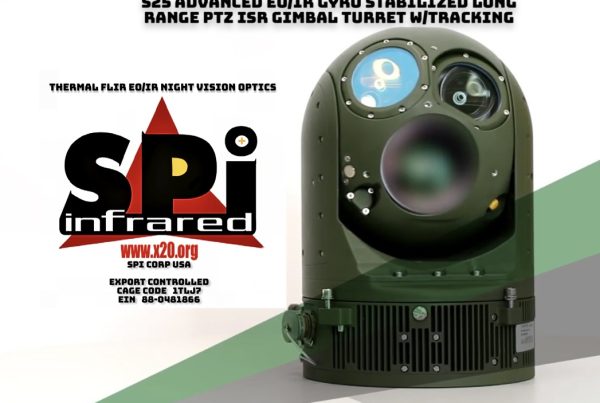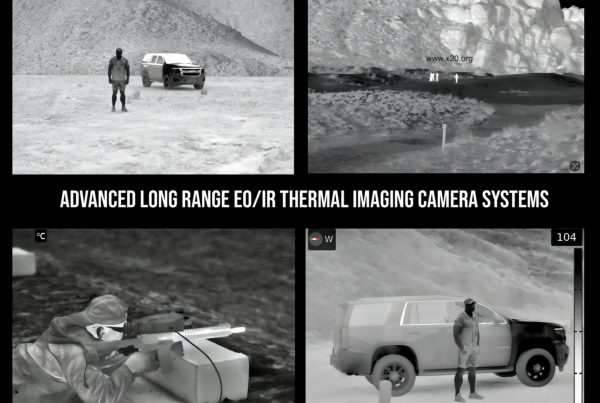Falcon military aviation NVG night vision goggles
High performance, high sensitivity Gen IV milspec aviation night vision goggles available in Green or white phosphor hand select latest generation US image intensifier tubes.
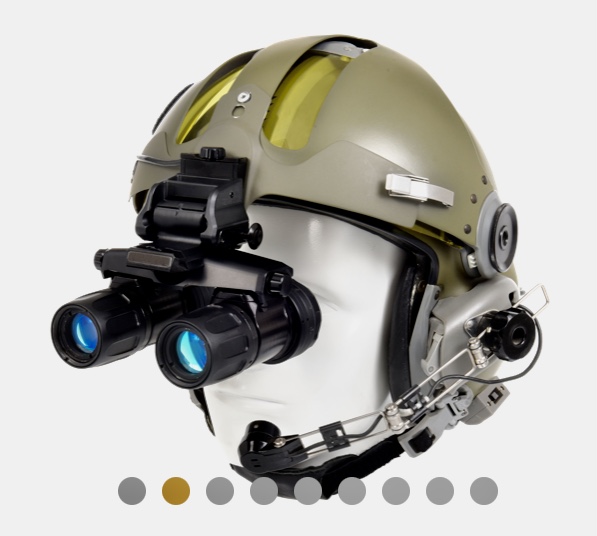
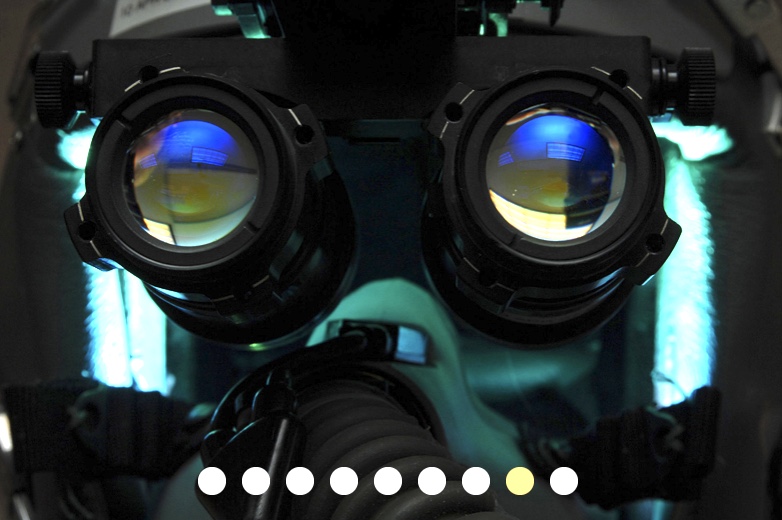
The Falcon Aviator Night Vision Goggle System represents a variant of the AN/AVS-6(v)/9 series ANVIS Night Vision Goggle (NVG) which is the US Army/Navy standard fielded issue. X26 brings a new level of performance to the system by offering the high performance, high sensitivity Falcon with both standard P-43 green and high contrast P-45 white phosphor image intensifier tubes.
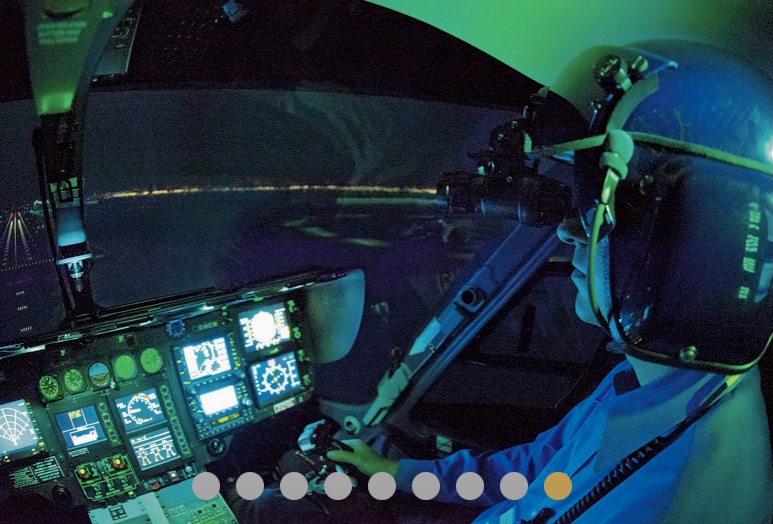
The Falcon Aviation NVG System is equipped with Class A or Class B filter coatings on the objective lenses and offer a 40° minimum field of view. The large format 27mm eyerelief eyepieces can be adjusted from +2 to -6 diopters for most corrective lenses. In addition, the Falcon Aviators Night Vision Goggle accommodates inter-pupillary spans between 51mm to 72mm and offers over 100 of tilt adjustment to compensate for a wide range of in-service helmet applications.
Ground based tactical wide field of view night vision goggles
are also available from SPI
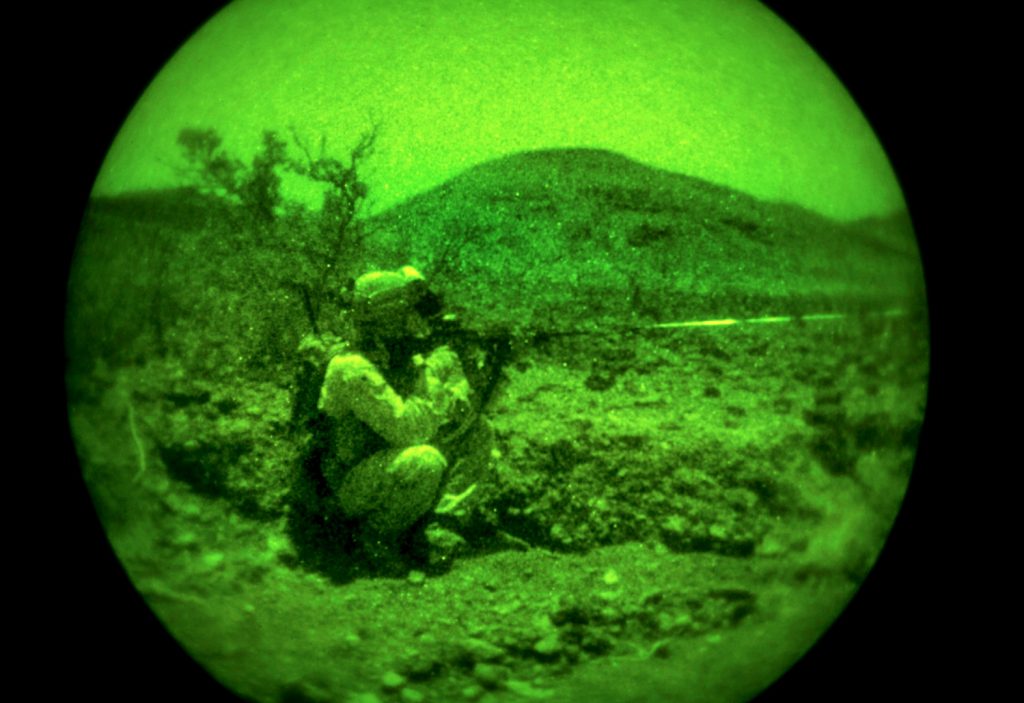
SPECIFICATIONS
| Optics / Field of View: | Typical F0.95/40° |
| Magnification: | 1.0X |
| Type / System Resolution: | Hand Select clean green / white phosphor US gen 4 image intensifier tubes – min 64 lp/mm / 1.3cy/mR minimum |
| Diopter Adjustment: | -6 to +2 |
| IPD: | 52mm – 72mm |
| Vertical Adjustment: | 25mm |
| Fore/Aft Adjustment: | 27mm |
| Convergence: | 1.0° |
| Dipvergence: | 0.33° |
| Tilt Adjustment: | 10° |
| Focus Range: | 25cm to infinity |
| Battery Type/Life: | AA 1.5VDC / 80 hours battery pack load |
| Binocular: | 498g |
| Mount: | 149g |
| Environmental: | MIL-STD-810H |
| Package includes | Ruggedized Falcon Prime aviation NVG Unit Assembly, Helmet Mount Assembly, Soft Carrying Case, Counterweight, 4 each AA Batteries, Battery Pack Assembly, Neck Cord, Lens Tissue, Screwdriver, NVG Manual |
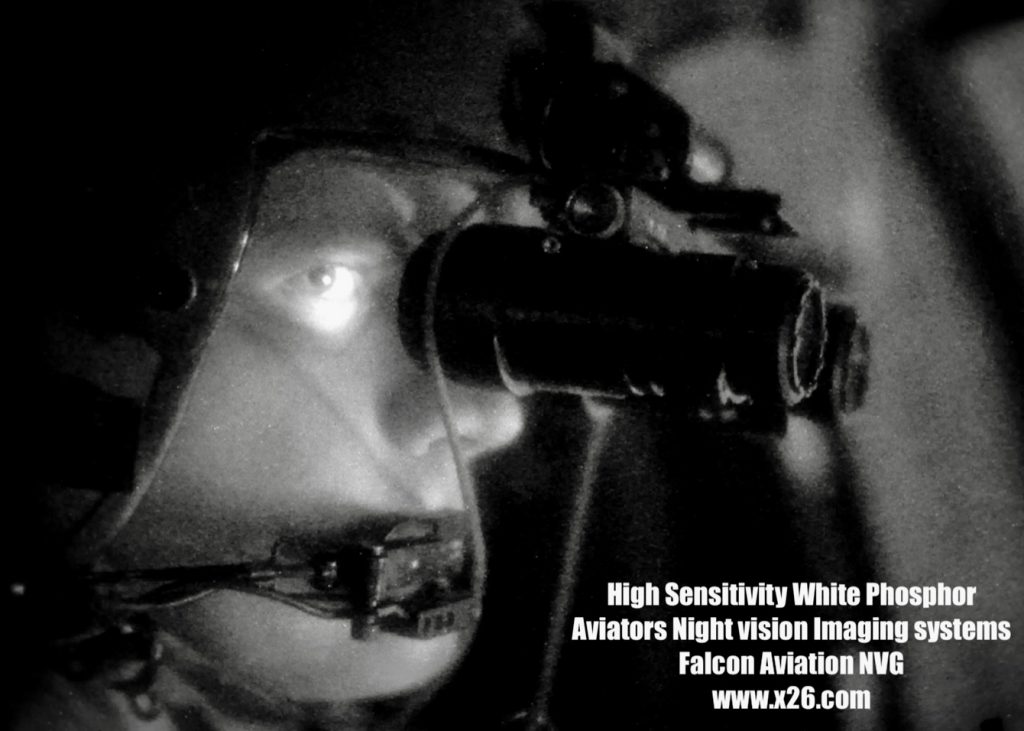
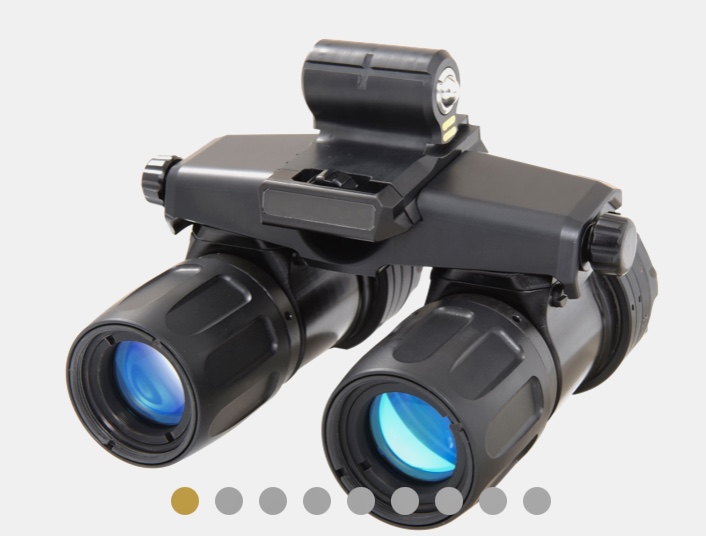
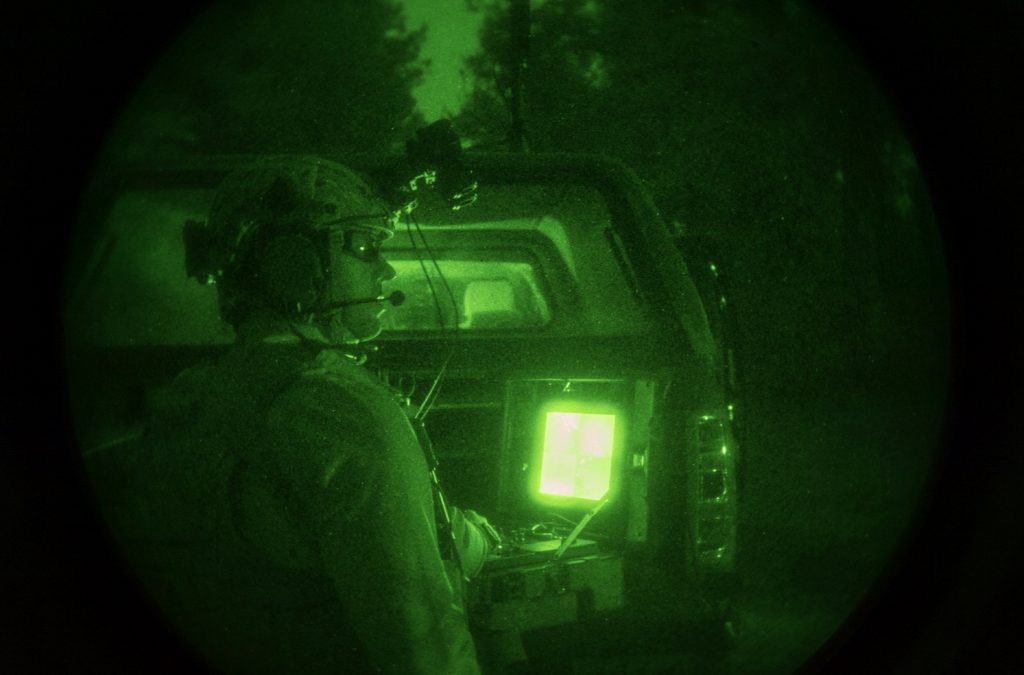
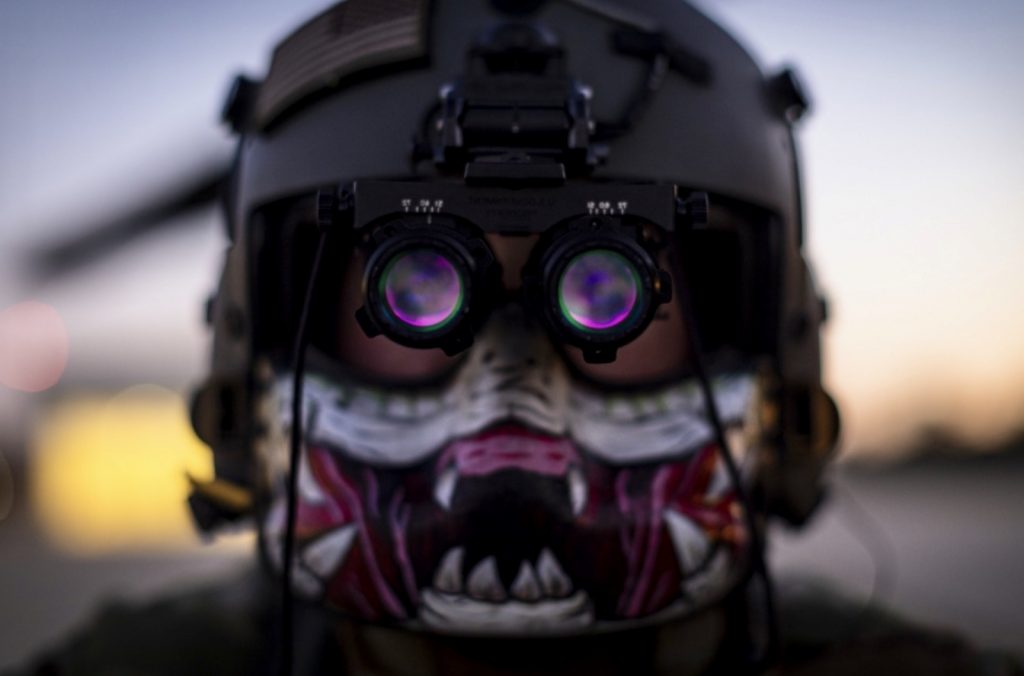
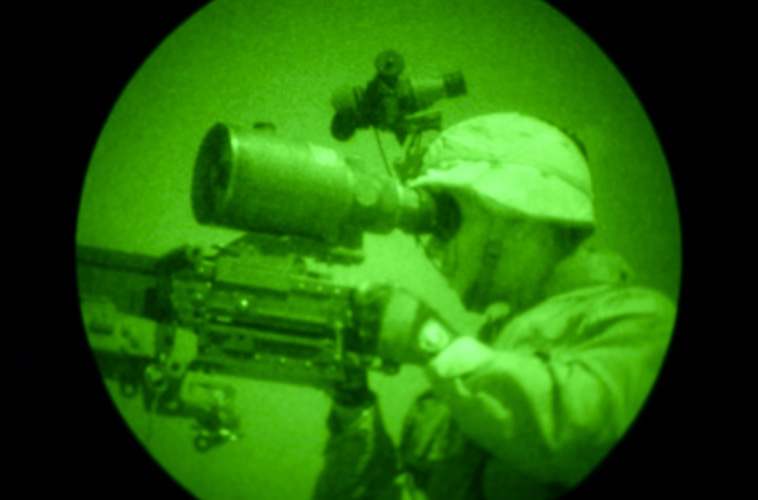
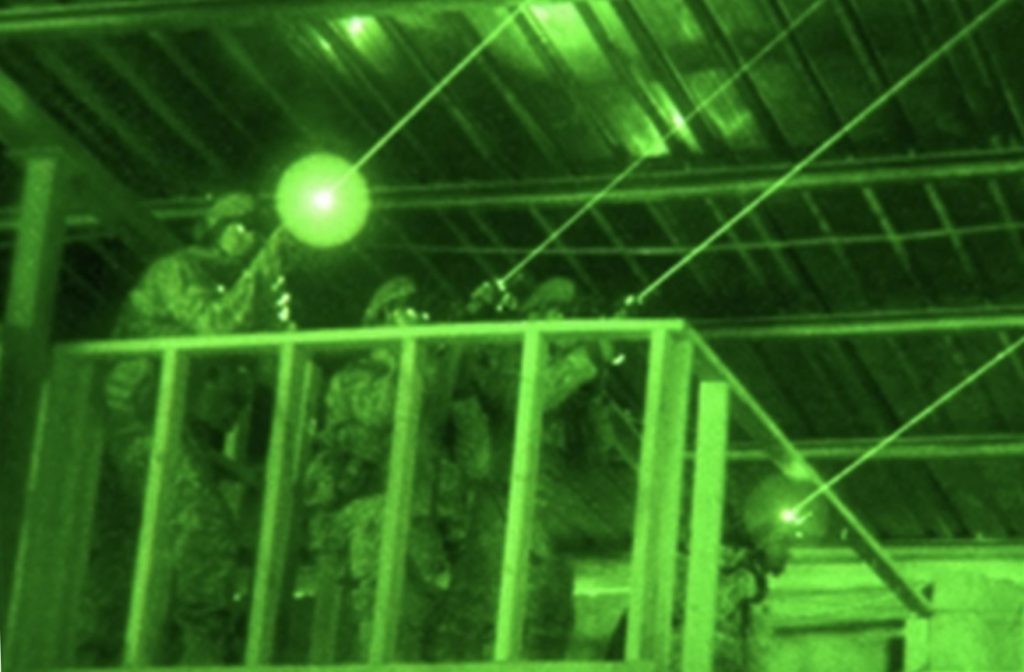
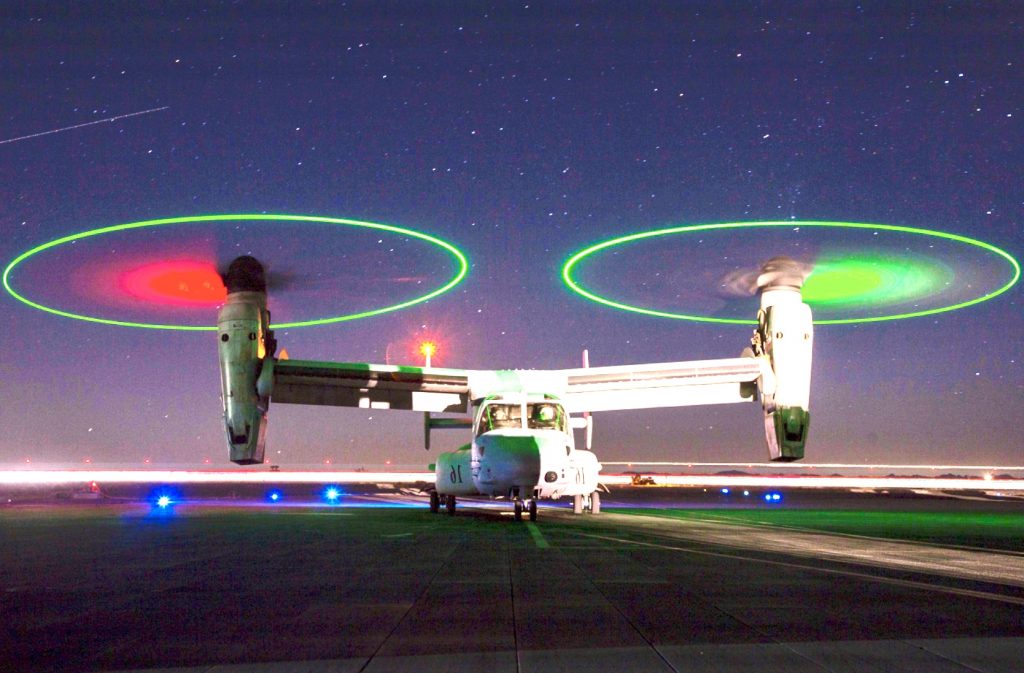
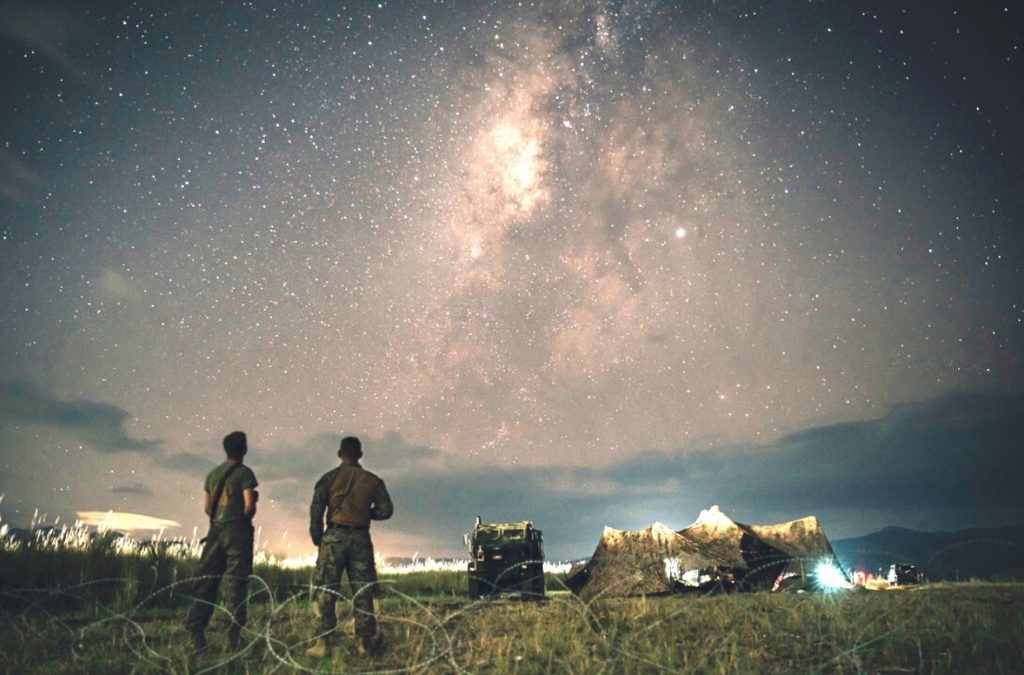
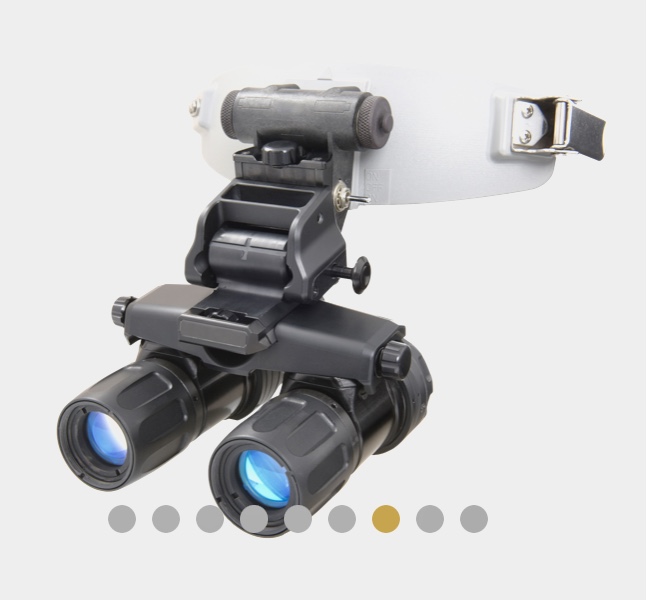
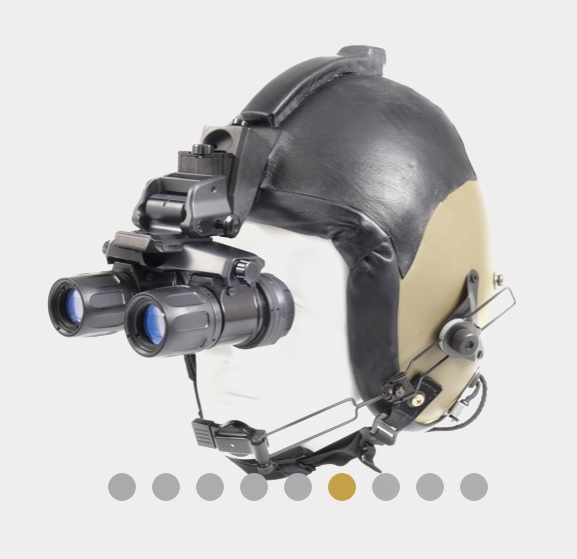
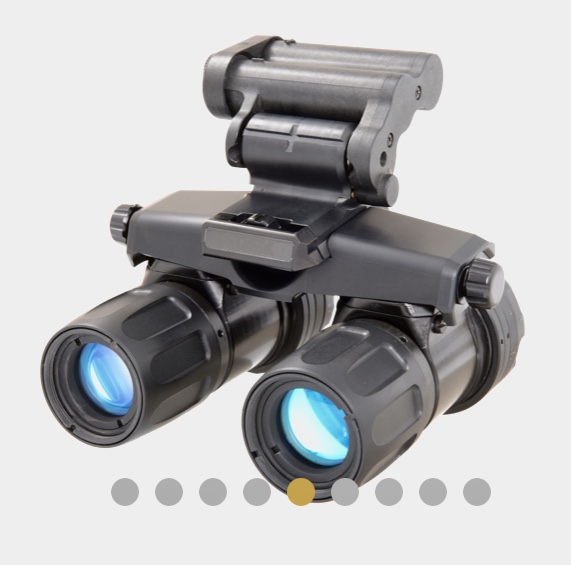
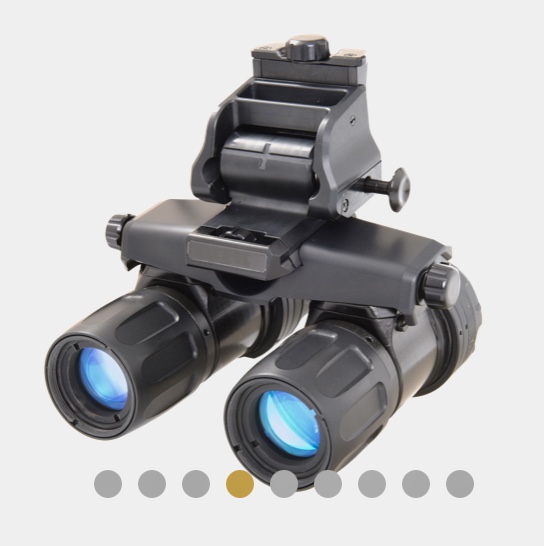
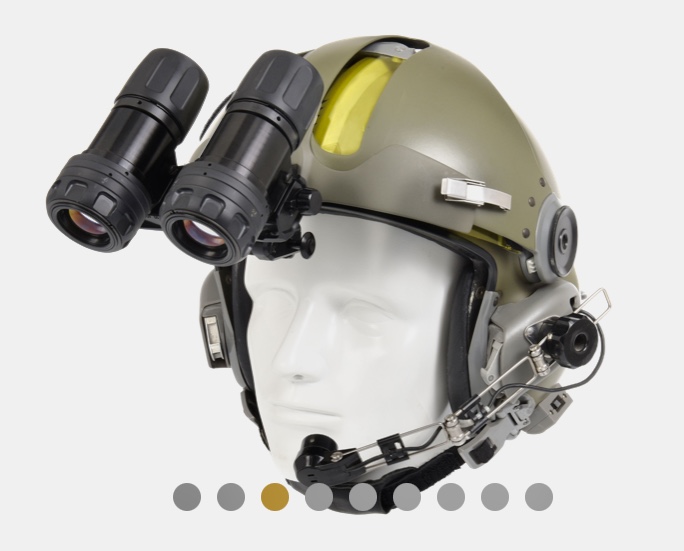


The ability to conduct military operations effectively at night has been recognized as an important goal for many years. Many technologies have been applied to this problem. Image intensification (I2) is one technology that has substantially increased the ability of the military to operate at night. With I2 devices an individual can see and function under conditions of darkness.
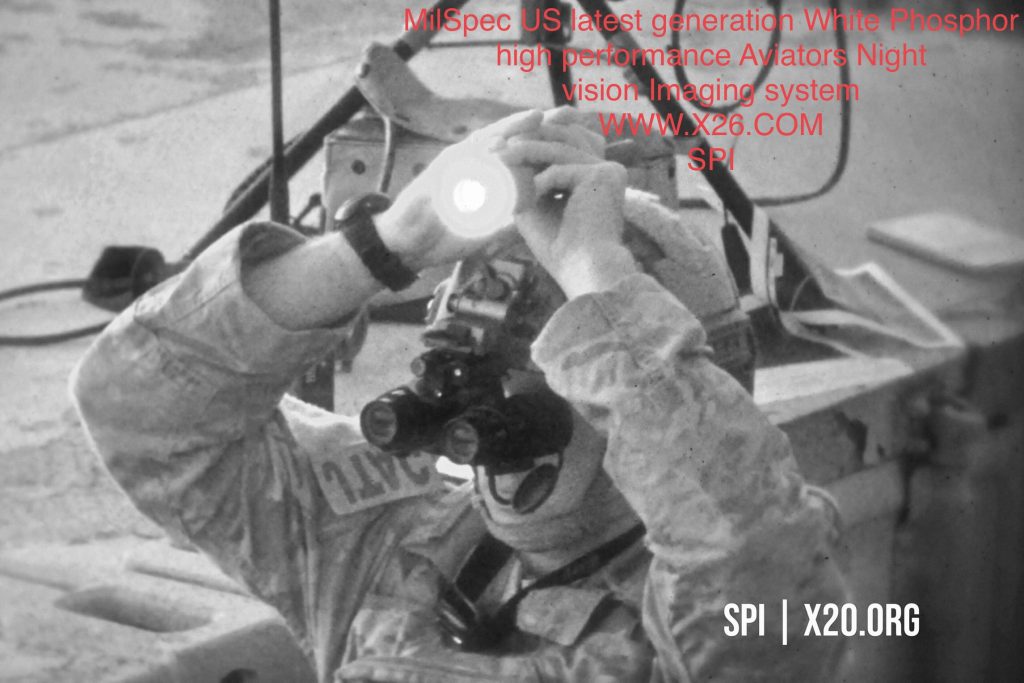
The principle underlying I2 technology is relatively simple. Image intensifiers amplify portions of the electromagnetic spectrum. Reflected or emitted light is amplified and presented as a usable image to the eye. The intensified imagery is between 2,000 and 7,000 times greater than the original scene depending on the NVG used (Reising, Martin, & Martin, 1997).
The subject of this review is one type of image intensification equipment used heavily by ground forces — night vision goggles, known as NVGs. Ground forces also have I2 weapon sights, and there are some references to these systems as well. Additionally, NVG research dealing with aviation issues is included when applicable to ground forces. The following questions are addressed in the review:
• WhatisknownaboutsoldierperformanceusingNVGs?
• What critical aspects of soldier performance with NVGs remain to be investigated?
• What NVG training do soldiers typically receive?
• What improvements are needed to improve current NVG training to enable leaders,
soldiers, and units to maximize employment of NVGs?
In the 1990s, some long-standing ground force training issues were resolved as part of the Army’s own-the-night initiative. However, not all were resolved and the review identifies issues
In Wiseman’s (1991) accounting of night vision device development, he noted that image intensifiers were developed by the U. S. military in the 1950s. However, the Germans had experimented with this technology during World War II. First-generation devices, known as starlight scopes, were fielded in the 1960s (Wiseman, 1991). With second-generation technology, night vision goggles were produced and fielded in the 1970s. Third-generation goggles were fielded in the 1980s. Table 1 lists the image intensification devices (sights and goggles) referred to in the review. The two first-generation devices in Table 1 are no longer in the U.S. Army. These devices are listed, however, because the research involving them provided information pertinent to the effective use of currently fielded devices.
Table 1
Night Vision Devices Cited in the Review
Nomenclature AN/PVS-5
AN/PVS-7A and AN/PVS-7B AN/PVS-7D
AN/PVS-14
ANVIS (AN/PVS-6)
AN/PVS-2A AN/PVS-4
AN/TVS-2 AN/TVS-5
AN/VVS-2
Description Night Vision Goggles
Second-generation, binocular; unity power. Used by ground forces & aviators; replaced by AN/PVS-7 for many ground forces, but still used by many wheeled vehicle drivers. Replaced by ANVIS & other third- generation goggles within aviation community.
Third-generation (the first fielded versions were second-generation). Biocular; unity power; worn by ground forces; head harness required. Difference between the two versions is the head harness and location/type of controls. NVG tests involved both generation tubes. Beginning in 1993, AN/PVS-7B goggles were issued with a helmet mount.
Helmet-mountedbiocularthird-generationgoggles. Unitypower. Also incorporate a compass.
Monocular, helmet mounted, enhanced third-generation goggles with compass. Unity power. Detachable for handheld mode.
Third-generation, binocular; unity power; worn by aviators; mounts on helmet.
I2 Weapon Sights
First-generation, starlight scope; typically mounted on small arms (e.g., M16A1). 4 power; replaced by AN/PVS-4.
Second-generation; some tests examined prototype third-generation sights. Currently mounted on squad automatic weapon (SAW); also compatible with Ml6, M60, M72 LAW, & M79 grenade launcher; 3.8 power.
First-generation starlight scope used on medium & heavy (e.g., M2 & M40) machine guns. 6.5 power; replaced by AN/TVS-5.
Second-generation weapon sight used on medium & heavy machine guns (e.g., M40 & M2). 6.5 power.
Driver’s Viewer
Second-generation (some tests examined third-generation prototypes); biocular; current driver’s sight on the Bradley Fighting Vehicle & tanks. 4power.
Note: CATSEYES,Nl[TEOP,andEAGLEEYEareadditionalNVGstestedbytheaviation community.
InTable1andthroughoutthepaperthreetypesofgogglesarecited: binocular, monocular, and biocular. Binocular goggles employ two objective lenses and two I2 tubes, each
connected to an independent eyepiece display. Biocular goggles have a single objective lens and one I2 tube through which light is detected; the resulting image is split and displayed through two eyepiece displays. A monocular NVG also uses a single objective lens and one I2 tube, but only one eyepiece through which the image is displayed. With this type of NVG, only one eye is covered by the NVG; the other eye is unencumbered.
Much of the early research involved the AN/PVS-5 NVGs, the AN/PVS-7 NVGs, or both. The AN/PVS-5 goggles are binocular with second-generation I2 technology. The current AN/PVS-7gogglesareeitherbiocularormonocularwiththird-generationtechnology. Many major Army tests were designed to examine the changes in performance resulting from the change in goggle technology, as well as the effects of differing goggle configurations. For most ground forces, third-generation AN/PVS-7 goggles have now replaced the second-generation AN/PVS-5goggles. Similarly,withintheaviationcommunity,third-generationbinocular Aviator’s Night Vision Imaging System (ANVIS) goggles are in use. For ground forces, the goggle configuration has changed from binocular to biocular, with a monocular configuration proposed for the Army’s Land Warrior system.
The topics in this report are as follows. First, background information on image intensificationtechnologyispresented. Second,researchrelatedtoequipmentandlighting issues is considered, followed by a discussion of research on visual issues with NVG use. Next investigations of performance issues, including target detection and recognition, scanning, and night firing, are examined. Research on both mounted and dismounted movement is then addressed. Lastly, suggestions for further research on NVG training and performance, and training materials are offered.
Image Intensification Technology
Both second- and third-generations of goggles are sensitive to portions of the electromagnetic spectrum (see Figure 1), specifically visible and near infrared (IR) wavelengths (see Figures 2 and 3). NVGs are sensitive to energy from natural sources (moon and stars) and from artificial sources (flares, headlights, and nearby towns). Much of this energy is visible. But the moon, stars, and other light sources also emit a significant amount of near IR energy that cannot be seen by the human eye, but can be seen with NVGs (Verona & Rash, 1989).
There are important performance differences between the second-and third-I2 generation NVGs. A primary difference is their spectral sensitivity (see Figures 2 and 3). The wavelengths towhichthehumaneyeissensitivearefromapproximately400to700nanometers. Second- generation devices are sensitive to wavelengths between approximately 400 and 900 nanometers, which covers the entire visible spectrum, plus part of the near infrared (Verona & Rash, 1989). In contrast, third-generation devices are sensitive to wavelengths of approximately 550 to 950 nanometers. This includes only part of the visible spectrum, and extends further into the near infrared. This difference in the second- and third-generation I2 devices means that objects may havedifferentintensitieswhenviewedthroughthedifferenttubes. Aprimaryimpactofthis difference for the soldier is that third-generation goggles are more sensitive to near IR sources of
radiation in the night sky and therefore function better under starlight conditions than second- generation goggles (Verona and Rash, 1989).
Another critical difference for ground forces is that third-generation devices have a much great photocathode sensitivity (i.e., 1,100 micro-amperes per lumen) compared to second- generation intensifiers (300 micro-amperes per lumen). According to Morrow (1989), “In general, detection range performance is directly proportional to the square root of the cathode sensitivity” (p. 20). Thus targets can be detected at greater ranges with third-generation NVGs. A third difference is in the NVG visual acuity obtainable under optimum conditions. Visual acuity is better with the third- than the second-generation tube, the best acuity being 20/40 with thethird-generationand20/50withthesecond-generation. Second-andthird-generationI2 devices also differ in the average life expectancy of the intensifier tube (Adcock, 1993). Tube life for second-generation devices is 2,000-4,000 hours with the signal decreasing throughout the tube’s life. In contrast, third-generation tubes last for 7,500-10,000 hours, with the signal remaining constant through this period and then dropping off suddenly (Verona & Rash, 1989).
OSCILLATIONS “|
WAVELENGTH (nanometers) (mil
*<f—-r- J LONG ELECTRICAL
WAVELENGTH (microns)
i- VIOLET/
Visible Light, Near and Far Infrared Portions of the Spectrum
Entire Spectrum
VISIBLE LIGHT
ULTRfr-VlOLET
INFRARED
Figure 1. Electromagnetic spectrum highlighting the visible and near to far portions of the spectrum [NVGs cover part of the visible and near IR ranges].
HMHO WAVES { MICROWAVES
1 KILOMETER (km)
1 METER
1 CEHTIMETE» (cm) 1MILLIMETER(mm)
1 MICROMETER (pM)
1 NANOMETER (nm) 1 ANGSTROM (A)
1 X-RAY UNIT
{ COSMIC RATS ■
RESPONSE (pA/waft)
y GEN 1 „tfHCATSEYES)
(ANVIS)
400
500 60Q
700 SOfl
WAVELENGTH (nanometers)
Figure2. Spectralresponseofthehumaneyeandsecond-andthird-generationNVGs(fromAir Force Armstrong Laboratory, Aircrew Training Research Division).
What do these differences in image intensification technology mean for the soldier? Under most conditions, the third-generation NVGs are better for the soldier. Under low levels of illumination including periods where starlight is the only source of illumination, the third- generation technology will allow the soldier to see better and farther. However, under full moon conditions, it could be hard for a soldier to notice a difference in the image seen through the two generations of goggles. The third-generation goggles also incorporate an automatic gain control feature. Thisreducesthelikelihoodofthe”white-out”problemwithNVGswhenexposedto flares, indirect fire, tracers, and other lights. The better visual acuity achievable with the third- generation goggles also helps the soldier.
HUMAN EYE (not to scale)
EYE 100l
60 –
(Percent %) 40
2D
RELATIVE RESPONSE
400 500
-VISIBLE – UGHT
700 ..-800- m WAVELENGTH (nanometers)
+ -INFRARED-
Figure3. Nightskyradiationanditsrelationtothird-generationNVGspectralsensitivity(fromAir Force Armstrong Laboratory, Aircrew Training Division).
Equipment and Lighting Factors
Lighting
Although NVGs allow soldiers to operate under conditions of darkness, the goggles must have some source of illumination to function. In fact, as levels of illumination decrease, there is acorrespondingdeclineinthequalityoftheimageprovidedbyNVGs(Brickner,1989). Sources of illumination may be natural (e.g., starlight, moonlight) or artificial (e.g., flashlights, lasers, flares,mortarrounds). Althoughthisportionofthereviewfocusesonsourcesofillumination, atmospheric conditions (e.g., dust, moisture, and haze) also affect NVG performance (Brickner,
1989). Third-generation NVGs penetrate atmospheric disturbances better than do second-generation NVGs (Haidn, 1985). However, the third-generation NVGs are still subject to weather induced effects, mainly phenomena that cause a direct loss of ambient light (e.g., thick rain and clouds).
Whatever the source, certain light characteristics are important to NVG performance. For instance, both the intensity and wavelength of light sources can create NVG compatibility problems, particularly when artificial light sources are involved. An intense light source can createabloomingeffectinNVGs. Third-generationgoggleshavebeendesignedtoreducethis effect; the entire image adapts momentarily to the immediate level of illumination. If the wavelength of a light source falls within the range of wavelengths to which I2 devices are sensitive,thedevicewillamplifythelight,possiblycausingbloomingordevicecutoff. [Device cutoffprotectstheimageintensificationtube.] Therefore,lightingissuesareimportant considerations when planning night operations and using lights during mission execution.
For the ground soldier, night operations are conducted with minimal use of lights; light discipline is strictly enforced. However, soldiers may use flashlights to read a map with their unaided eye. They may use various light sources, both visible and IR, for purposes of marking and signaling. Nevertheless, once the battle begins, the battlefield can be lit by tracers, indirect fire from artillery and mortar rounds, flares, and fires. The effects that such light sources have on the soldier’s ability to use NVGs and how NVGs should be employed must be considered in planning and training for night operations.
NVG incompatibility with colored lights. NVGs maintain a constant image brightness with an automatic brightness control (ABC) feature. When the input from lights exceeds a certain threshold, the intensifier gain is decreased in order to maintain a constant image brightness. Close”lightsthatemitenergywithintherangeofthespectralresponseoftheNVGs are considered incompatible if they activate the ABC, decreasing intensifier gain. With decreased gain, there is a corresponding decrease in image contrast which degrades NVG-aided visual performance.” (Gibb & Reising, 1997, p. 1). Blooming of red light sources can also occur.
As indicated in Figure 2, NVGs are sensitive to the visible portions of the spectrum. This presents a particular problem for aviators in that red lights have been used traditionally for cockpit lighting because red does not adversely affect dark adaptation of the crew. However, NVGs are sensitive to red lights (Haidn, 1985), as the wavelength of red light is 620 to 700 nanometers(seeFigure1),withinthespectralresponseofNVGs. TheANVISgogglesusedin the Army have a cut-off filter placed at 625 nanometers1, also known as the minus blue filter. With this filter, the ANVIS goggles do not sense and amplify light at wavelengths shorter than the orange region of the spectrum, that is, blue, green and violet (see Figures 1 and 3). Consequently they are compatible with green and blue light, but not red light. The design of the ANVIS goggles allows aviators to look under them, so the instrument panel can be read with the
1 Personal communication with Brian Gillespie, Night Vision and Electronic Sensors Directorate, February 23, 1998. The Navy and the Air Force have a cut-off at 665 nanometers in their ANVIS goggles.
unaided eye. The ANVIS themselves respond well to outside lighting, which in starlight is mostly red and infrared (Miller, Provines, Block, Miller, & Tredici, 1984).
Extensive research has been conducted on solving the red light compatibility problem2. The aviation community has modified the lighting in some cockpits (e.g., changing some red lights to green/blue), and is continuing to work on other solutions3.
Contrasted with the ANVIS goggles, NVGs used by ground soldiers do not have a cut-off filter. The extent and seriousness of the problems created by incompatible lights for soldiers has not been investigated as extensively, although the automatic gain feature of the third-generation NVGs has reduced some problems. Some researchers (Rash & Martin, 1989a, 1989b, 1990) investigated filters that would make flashlights compatible with goggles so color-coded maps could be easily read. None met NVG compatibility requirements.
Effectsofbrightlights. Severaltestsexaminedtheeffectsofvariouslightsources, typically white light (e.g., car lights, tracers, flares, aircraft lights, strobes, artificial illumination, lasers, streetlights), upon NVGs. First- and second-generation image intensification devices experience greater blooming and halo effects when exposed to sources of bright light than do third-generation devices (Brickner, 1989). This is due to the automatic gain control feature in third-generation devices, which causes the image to adapt to the immediate level of illumination.
Reising et al. (1997) provided a good description of NVG halos (blooming) and the conditions under which they occur. A halo is a circular area of brightness on the image screen resulting from a small bright source of light. A halo does not occur if the point source of light is of low intensity and/or sufficient distance from the NVGs. As the distance decreases or the intensity increases, a distinct halo appears around the light. The diameter of the halo will increase when the intensity of the light source is sufficiently great, the distance to the source is
2 The use of chemical lights was studied as a temporary solution to the problem of NVG incompatiblecockpitlighting. Simmons(1989)determinedthatgreenchemicallightsprovided sufficient flight instrument illumination and that they did not interfere significantly with NVG use, if they did not directly illuminate the NVGs. Blue chemical lights were found to be completely compatible with NVGs, but they did not provide sufficient instrument illumination. Breitmaier and Reetz (1985) described proposed NVG aircraft cockpit lighting compatibility specifications. The authors proposed that cockpit lights should be no brighter than the outside scene when viewed through ANVIS. Additionally, Genco (1985) stated that for NVGs to be most effective, aircraft cockpit lighting must be optimized for the NVGs’ spectral sensitivity. GencoalsoproposedcriteriaforNVGcockpitlightingcompatibility. Schumacher(1996)tested the NVG-compatibility of a cockpit lighting kit for the F-16C.
3 Personal communication with Brian Gillespie, Night Vision and Electronic Sensors Directorate, February 23, 1998. TB 1-1500-346-20, dated 15 April 1992 specifies that red or white lighting in the cockpit of Army aircraft must be filtered or turned off prior to conducting NVG operations. Supplemental blue-green lighting with lip lights, finger lights, chemical light sticks, etc. can be used with the specific configuration authorized by the unit commander.
8
reduced substantially, or both. At that point the automatic brightness control is triggered, the intensified gain decreases, and the image appears to “wash out.”
Tests using all generations of I2 devices have repeatedly documented the temporary blindness produced when the user is exposed to bright lights. For example, in an early test Clement (1975) investigated the effects of artificial illumination (i.e., 155mm flares and AN/VSS-3A searchlights) on the surveillance and target acquisition capability of first-and second-generation image intensification devices, including the AN/PVS-5 NVG. Use of artificial illumination under bright moonlight conditions was found to degrade the target acquisition capabilities. Artificial illumination also introduced device blooming, glare, and flickering shadows. Verona and Rash (1989) also stated that flares, rocket motors, strobe lights, lightning, and other bright light sources may temporarily affect second- and third-generation NVG performance.
Soechting and Kennedy (1987) compared the AN/PVS-7s (equipped with both second- andthird-generationtubes)totheAN/PVS-5s. Whendriving,anindividualcouldnotseeaftera brightlightwasencounteredtothefrontofthevehicle. However,thelengthofthetemporary blindness caused by bright lights was not assessed. In mortar live firing, soldiers encountered temporary blinding from the muzzle flash. However, the muzzle flash of the M16A1 rifle did not affecttheNVG. ThetestsalsoindicatedthattheNVGIRilluminatorcouldbeseenat15mwith unaided vision and at 35m (the maximum distance tested) with another NVG.
In the U. S. Army Infantry School Dismounted Warfighting Battle Lab’s (DWBL, 1993) evaluation of different mixes of night fighting equipment, soldiers reported that light from laser pointers reflected off the fog and whited out the goggles. Additionally, the multiple integrated laser engagement system (MILES) lasers and artillery simulators frequently caused goggles to white out. Furthermore, soldiers noted that the NVGs bloomed when operated in close proximity to large numbers of active emitters and tracers.
On the battlefield and in training, NVGs in conjunction with aiming lights greatly increasethecapabilityoftheinfantrymantohittargetsatnight. Typically,thereisnoblooming associated with aiming lights when shooting at targets at a distance. But NVG halos do create problems in zeroing aiming lights to the rifle (Patterson & Jones, 1978). The firer has difficulty achieving a definitive center of mass aim point from which aiming light adjustments can be made. As stated, the blooming effect in NVGs is particularly large when the light source is close,verybright,orboth. Theaiminglightiszeroedatcloserange(25m)usingawhitepaper target. When the beam from the aiming light strikes this target, light is reflected in the firer’s goggles and blooms, making it difficult to aim consistently at the desired point. Firers indicated (Dyer, Smith, & McClure, 1995) that the bloom of the aiming light through the goggles typically masked the horizontal and vertical zero lines used to determine the aiming point.
Although difficulties in getting a definitive point of aim were identified in the initial test of the aiming light (Patterson & Jones, 1978), these difficulties were not resolved at that time. Later, a field-expedient solution to this problem was found (Dyer et al, 1995). Black electrical tape was used to stripe the full length and width of the tan side of an E-silhouette, dividing it in
half. The zero paper target was then centered on this E-silhouette. The tape extended the vertical and horizontal 0 lines beyond the target’s border, allowing these center lines to be seen by the firerandtoprovideaconsistentaimingpoint. Firersdirectedaflashlightatthetargetfromtheir firingpositioninordertodiffusethebloomoftheaiminglightintheirgoggles. Smallershot groups resulted from this procedure, and all live-fire zeroing was conducted within the 18 rounds allowed.
Dry-fire boresighting procedures have also been developed (Dyer, et al., 1995; McDonald, 1997a). Although different mechanically, both procedures are based on the concept of having the firer obtain a good point of aim at the boresight target (with iron sights or with a borelight), and then adjust the aiming light to its appropriate offset for the distance to the target. These procedures require a second individual, wearing NVGs and standing close to the target, to tell the firer in what direction(s) to adjust the aiming light. The borelight technique (McDonald,
1997a) has been developed for many weapon and aiming light combinations and can be conducted during day and night. Dry-fire procedures have a definite advantage over live fire as they eliminate the need to use ammunition in obtaining a good zero for night firing and eliminate the blooming effect from the zero target at 25m.
Impact ofNVGs on dark adaptation. Finally, the effect ofNVGs on the dark adaptation level of the user’s eye must be considered in ground force operations. NVGs are not worn constantly by all soldiers. Because of the human factor problems associated with NVGs, soldiers often remove their goggles from the head harness to reduce discomfort. In some doctrine and training manuals (Department of the Army [DA], 1986, FM 7-70), it has been recommended that soldiers rotate night vision equipment so that “soldier vision ‘burn-out’ does not occur” (p. D- 37). Once a conflict begins and the battlefield is bright from fires and other lights, the unaided eye may be the more appropriate sensor system. Therefore, it is important for soldiers and leaders to know the consequences for dark adaptation when switching from NVGs to the unaided eye.
When viewing through NVGs, the user is not fully dark-adapted (Brickner, 1989); the human eye is twilight-adapted (Böhm, 1985; Rabin & Wiley, 1994), as the luminance of the NVGdisplayismesopic(twilighttolowphotopicrange). Severalexperimentsexaminedthe dark adaptation process after removal of NVGs.
The Combat Developments Command (CDEC, 1970) conducted a field test that considered the speed of dark adaptation recovery after short-term use of first-generation I2 devices (time to identify a target followed by one min of scene viewing through a device display). Recovery time varied inversely with the ambient light level; that is, faster recovery times were associated with higher levels of illumination. Under the high-light condition, full recovery occurred in one to two min. Recovery occurred within two to three min in the mid-light condition,andwithinthreetofivemininthelow-lightcondition. Glick,Wiley,Moser,andPark (1974; see also Wiley, Glick, & Holly, 1983) investigated the time to reacquire dark adaptation afteruseoftheAN/PVS-5NVG. Sixmaleparticipantsweredarkadaptedfor30min, subsequently wore goggles for five min, and then were reassessed for dark adaptation until the 30 min level of dark adaptation was regained. After wearing the NVGs, the soldiers’ level of dark
10
adaptation was equivalent to only 10 min of dark adaptation (range from 7 to 13 min) compared to the 30 min level of dark adaptation achieved before putting the NVGs on. The average recovery time (i.e., back to the 30 min level) was 2 min (range from 1.5 to 3 min). The authors stated that the re-adaptation time is a function of both the intensity and the wavelength of the NVG.
The interruption of dark adaptation by image intensification devices was shown to affect task performance in a series of experiments by Easley, Wright, Warnick and Gipe (1969). The useofimageintensificationdeviceswassimulatedintheseexperiments. Soldierslooked through infrared binoculars and were exposed to a light with an intensity of four foot-candles (equivalent to average illumination from a starlight scope – first-generation I2 device). After exposing both eyes to this light for five min, soldiers were allowed different times to dark adapt, ranging from zero to six min, and then had to follow a guideline (engineer tape) for about 65 ft (20m)understarlightconditions. Theshorterthedarkadaptationtime,thecloserthesoldier had to be to see it. Other experimental variations examined the effect of interrupting dark adaptation in one eye or alternately in each eye upon following the guideline and firing unaided at night. These experiments also demonstrated the need to allow soldiers time to dark adapt after using image intensification devices. Exposure to light was never greater than five min in any of theexperiments. Theauthorsrecommendedthatthreeminbeallowedforreadaptationtothe dark. Someoftheseexperimentscouldbeconsideredprecursorstorecentinvestigationsofthe advantages and disadvantages of monocular versus biocular goggles.
None of the research reviewed examined the effects upon dark adaptation with third- generation biocular and monocular goggles, nor the effects of wearing the goggles for a substantialperiodoftime. Thedisplayofthird-generationNVGsisslightlybrighterthanthat with second-generation NVGs, which should increase the time required to dark adapt after removal. However, the time to recover should vary with the configuration ~ biocular versus monocular. Theusershouldexperienceagreaterdelaywiththethird-generationbiocular configuration, but require less or no recovery time with the monocular version as the user’s unaided eye is already dark-adapted.
NVG Human Factor Issues
A number of studies considered human factor issues associated with NVGs, both aviator and ground force versions. A frequent means for identifying human factor issues has been the survey. Frequently reported concerns include focusing and other goggle adjustments, headaches, eyestrain,muscularfatigue,andtheweightandforwardcenterofgravityoftheNVGs. The introduction of helmet-mounted NVGs into the ground forces in 1993 has alleviated many of the human factors problems cited in prior research with ground forces. Research on goggles used by aviators is presented first, followed by the tests on goggles used by soldiers.
Aviators. In a study that compared aviator night vision devices, including the AN/PVS-5 NVG, Palmer (1975) identified two problems with NVGs: refocusing requirements when switching between an external world view and an internal world view (in an aircraft cockpit), and eyestrain and fatigue after 1.5 hours of flight.
11
Substantial human factors problems were associated with the AN/PVS-5 NVGs used by aviators. Chastain,Ton,andKubala(1979)investigatedtheeffectsoffatiguecausedbythe AN/PVS-5 NVGs. Aviators and motorcycle scouts completed a questionnaire to determine the types and frequencies of problems associated with goggle use. The aviators completed the questionnaire after an NVG-flight averaging 1.6 hours; the motorcycle scouts, after an NVG mission averaging in 1.5 hours. Twenty of 21 aviators reported physical discomfort while wearingtheNVGs. Fiveof6motorcyclescoutsreporteddiscomfortwhilewearingtheNVGs. Aviators were able to wear the NVGs an average of 42.5 min before the onset of discomfort. However, the motorcycle scouts wore the goggles an average of 29.2 min before discomfort was noticeable. Experienced aviators indicated that tasks were performed more easily with NVGs, whereas less experienced aviators preferred the unaided eye. Further, less experienced aviators reported experiencing physical discomfort sooner after wearing the goggles. Additionally, the researchers evaluated the performance of aviators on visual and motor skill tests. They found that eye-hand coordination seemed to suffer after a period of NVG use. However, with practice, performance approached that of non-fatigued individuals.
Further investigation of the effects of fatigue on visual and motor skills from a NVG flightwithAN/PVS-5swasconductedbyChastainandKubala(1979). Theresearchers identified critical or frequent helicopter maneuvers and tasks. These tasks and maneuvers were then related to the specific visual and motor skills involved. Tasks such as rotary pursuit, two- hand coordination, and discrimination reaction time tests were included. Aviators were tested before and after a NVG flight, that ranged from .75 to 1.5 hrs. Although there was some evidence that eye-hand coordination and reaction time tended to suffer after NVG flight, there was no strong support for the hypothesis that fatigue from NVG flight lead to performance decrements on important helicopter operation skills. However, it was noted that the NVG flights may have been too brief to result in levels of fatigue sufficient to degrade performance.
Stone and Duncan (1984) investigated the effects of extended use of the AN/PVS-5 NVG onaviators’performanceontwo,six-hourmissions. OnemissionwaswithNVGsandtheother wasduringthedaytime. TwoofthetenpilotscouldnotcompletetheNVGflightportionofthe experiment. One resigned in “extreme discomfort” after five hours of NVG flight. The other pilot was withdrawn after displaying tremulousness of the extremities 3.5 hours into the NVG flight. Problems and complaints by the aviators in response to questionnaires included a restricted field of view, the weight of goggles and the distribution of the weight on the helmet (causing chafing of the scalp), a lack of depth perception, refocusing requirements (between inside and outside of the cockpit), poor resolution, lens fogging, a lack of concentration, a decline of mental alertness, nausea, upset stomach, and eye strain.
The offset center of gravity associated with some NVG configurations may cause muscular fatigue that may degrade user performance (Verona & Rash, 1989). Haidn (1985) reported that an aviator experiences physiological effects due to the additional weight the NVG places on the head. NVGs and associated aviator equipment (e.g., Nuclear-Biological-Chemical [NBC] protective equipment) put stress on the vertebral system and muscles in the neck and back of the wearer. Additionally, vibrations transmitted to the body cause rapid fatigue and reduced
12
missiontime. HeindicatedthattheuseofNVGsmayproduceminorcomplaintsfrom individuals with normal, healthy vertebral systems, but may significantly increase the incidence of previous vertebral problems when NVGs are used for flight operations.
Some aviators responding to Crowley’s (1991) survey concerning sensory illusions reported that differences in brightness and gain between the binocular NVG tubes disturbed depthperception. Otherhumanfactorsproblemsmentionedincludedhelmetweight,eyestrain, headaches, and motion sickness. Both the AN/PVS-5 and ANVIS goggles were used by aviators in this survey.
The Air Force’s Armstrong Laboratory examined air crew members from a number of installations (Donohue-Perry, Hettinger, & Riegler, 1992; Donohue-Perry, Hettinger, Riegler, & Davis, 1993a, 1993b; Hettinger, Donohue-Perry, Riegler, & Davis, 1992,1993a, 1993b). Although the ANVIS system was used by most of the aviators, a small number reported using the AN/PVS-5 NVG. Therefore this research focused on the most recent versions of NVGs for aviators, compared to the earlier research with the AN/PVS-5s. It should be noted that ANVIS goggles eliminate many of the human factor problems associated with the AN/PVS-5s (Neal,
1983). The research included visual acuity measurements of NVG aided vision, documentation of NVG preflight adjustment procedures, a questionnaire, and an interview. Nearly all aviators improved their aided visual acuity (over their initial “usual” adjustment levels) after making adjustments with a special NVG resolution chart (see Figure 4 presented later). Additionally, as arulenostandardprocedureforpreflightNVGadjustmentwasemployed. Manycrewmembers reported that focusing (of the diopter and the objective lens) was the most difficult NVG adjustment. OnlyasmallnumberofaviatorsreportedhavingreceivedformaltrainingonNVGs, andonlyslightlymorethanhalfreportedreceivinginformaltraining. Frequentphysical complaints included muscular fatigue, eyestrain, drowsiness, difficulty focusing, and headaches. These effects were reported to become noticeable after two to three hours of NVG use. A sizable minority of aviators indicated a need for special eye protection designed for use with NVGs. Difficulties reported as occurring often or always with NVGs included confusion with lights, blowing debris, limitations in the field of view (FOV), limitations in depth perception, and loss of scene contrast. Interviews with the aviators revealed that they had to make more head movements when scanning with NVGs because of the limited FOV. It was also stated that when wearing the NVGs, they needed to use care and move at a slower pace when moving inside of an aircraftbecauseofproblemswithdepthperceptionandFOVlimitations. Theaviatorsalso indicated that incompatible cockpit lighting and glare off of the windscreen were common problems.
Groundforces. HumanfactorissueswerealsoaddressedinthemajortestsofNVGsused by soldiers. In general, these results parallel those with aviators. Most of the tests involved the biocular AN/PVS-7 configuration.
Initial tests with the AN/PVS-5 NVGs (U. S. Army Human Engineering Laboratory, 1975)showedproblems. Subjectiveevaluationsofgogglefit,comfort,andoperational suitability were collected during mobility and compatibility tests. Approximately 25% of soldiers indicated they experienced discomfort and pain over the front of the face and the bridge
13
of the nose when wearing the goggles. Additionally, some soldiers complained that the goggles fogged. All soldiers had problems with the interface between the goggles and the helmet. Goggle nasal contact was a severe problem, instability of the goggles during rapid maneuvering was a moderate problem, and focus difficulty was a slight problem.
The U. S. Army Infantry Board (1984) compared an early version of the AN/PVS-7, a biocularNVG,tothebinocularAN/PVS-5NVG. Amajority(53%)oftestsoldierscomplained that the eye lens on the AN/PVS-7 tended to fog up, even when demisting shields were used. Image quality of the AN/PVS-7, according to 93% of test soldiers, was better than that of the AN/PVS-5. SoechtingandKennedy(1987)evaluatedtheAN/PVS-7AandBNVGswithboth second-andthird-generationtubes. SoldiersfoundboththeAN/PVS-7AandBversionstobe uncomfortable. Additionally, soldiers complained of eyestrain and fogging with both the AN/PVS-7A and B NVGs.
A follow-on evaluation of the AN/PVS-7B NVG was conducted by Anton (1988). Individuals with contact lenses (worn with the goggles) and glasses (not worn with the goggles) reported difficulty with eyestrain, fatigue, and nausea. All of them had astigmatisms, for which the goggles provide no correction. All individuals reported discomfort from wearing the goggles. Manycomplainedofneckorshoulderpaincausedbytheweightofthegoggles. Itwas determined that the head mount assembly caused the goggles to be angled 10 to 15 degrees too high,andtheheadmountcouldnotbeadjustedtocorrecttheproblem. Thechinstrapofthe head mount fit individuals too tightly, causing discomfort, and when worn with a gas mask, breathing difficulty. The author noted the need to use the right hand when focusing with the IR light emitting diode (LED) should be addressed in training, because using the left hand casts a shadowontheviewingarea. Itwasalsonotedthatindividualsshouldbeinformedofthe possibility of experiencing dizziness and disorientation while wearing the goggles.
As described previously in the section on bright lights, the DWBL (1993) evaluated differentmixesofnightfightingequipment. ThegoggleheadharnessesfortheAN/PVS-7Aand Bwereagainfoundtobeasourceofcomplaintfromsoldiers. Theheadharnessesrequire completeremovalofthegogglesfromtheharnessforseeingwiththenakedeye. Soldiers indicated they were uncomfortable and that the center of gravity was forward of the face with no counterbalance, causing neck muscle strain. It was reported that the harnesses must be extremely tighttostayinplaceduringgroundmovement. Thecombinationoftheforwardcenterofgravity andheadharnesstightnessoftenresultedinheadaches. Theauthorsstatedthatahelmetmount andaheadharnesswithcounterbalancesareneeded. Further,theystatedthatNVGmounts should have flip-up capability that automatically turns the goggles off when in the flip-up position. Asindicatedpreviously,differentconfigurationsofNVGswithahelmetmountfor groundforceshavenowbeenfielded. FoggingofNVGlenseswasalsoaproblem.
Other investigations have included monocular NVGs. Thornton, Redden, and McDonald (1996) compared the AN/PVS-7B, two prototype monocular versions of NVGs, and a prototype holographic configuration. All goggles had a helmet mount. After a driving exercise, soldiers commented on the difficulty in having to refocus the goggles in order to read the odometer or the speedometer, similar to the problems cited by aviators when looking in and out of the cockpit.
14
Counterbalance weights were necessary to provide comfort on the monocular configurations. TheweightoftheAN/PVS-7Bonthehelmetinterferedwithfiringatnight. Thegogglespulled down on the helmet, which made the eyepieces sag in front of the soldier’s eyes instead of being alignedwiththem. Whenthisoccurred,soldierslookedoutofthetopedgesoftheeyepieces, whichproducedadistortedimageoftheaiminglightusedinfiring. Althoughthehelmet- mounted version of the NVGs alleviated some problems associated with the head harness, the system’sweightremainedunbalanced. InanothercomparisonofmonocularandbiocularNVGS (CuQlock-Knopp, Sipes, Torgerson, Bender, Merritt, McLean, & Myles, 1997), the biocular configuration was associated with tight neck muscles. But there were no significant differences in fatigue, annoyance and mental alertness.
Redden and McDonald (1996) examined only monocular, helmet-mounted NVGs includingtheAN/PVS-14. Theyfoundrelativelyfewhumanfactorsproblems. Soldiersreacted more favorably to the goggles as the test progressed. Those who had difficulty accommodating to a different image in each eye at test start, did not mention this problem at the end. Durable, lightweight configurations with a wide FOV were desired, although goggles with a FOV greater than 40° did not improve performance.
Reducinghumanfactorsproblems. Brickner(1989)offeredseveralsuggestionsfor reducingandpreventinganumberofusercomplaintsandfatigue. Someproblemscanbe reduced by NVG maintenance, correct NVG adjustments, and controlling incompatible light and reflection sources. Physical fatigue can be lessened by maintaining healthy physical fitness levels, strengthening neck muscles, and by using appropriate sitting posture as well as balancing the NVG. Test findings also indicate that proper training and experience with goggles are critical. With ground forces, there has been a constant improvement in goggle configuration in an attempt to alleviate many human factor problems. These efforts are continuing.
Finally, the protection of the eye from lasers was considered by Walsh (1990). He stated that NVGs provide mechanical laser protection of the eye, i.e., physically blocks the light. However, only macular, i.e., central vision, injuries are prevented. Peripheral retinal injury is stillpossible. ThesestatementswerebasedonacomputermodelingofANVISeyeprotection. Reising (1995) found that a laser eye protection device had a negative effect on NVG-aided visual acuity under low illumination conditions with medium and low contrast targets only.
NVG Induced Sensory Illusions
Sensory illusions have been associated with the prolonged use of NVGs by aviators. Many of these illusions seem to be related to characteristics of the image provided by NVGs. Researchers have surveyed aviators to determine common sensory illusions experienced with NVG use. Although no such research has been conducted with ground forces, many sensory problems encountered are likely to be common to aviators and ground forces. This similarity may be most pronounced when comparing the operation of wheeled and tracked vehicles to the operationofaircraft. Sensoryillusionsassociatedwithdistanceandmovementshouldbe particularlysimilar. Giventhissimilarity,themeansofavoidingorcompensatingforthese
problems, e.g., improved scanning techniques and better crew coordination, offered by aviators may benefit vehicle drivers as well.
IntensityanddistancecuesareeasilyconfusedwhenwearingNVGs. VeronaandRash (1989) stated that a light source can appear the same whether it is small and close or large and far away. Chromaticafter-effectshavebeenassociatedwiththeuseofNVGs(Moffitt,Rogers,& Cicinelli, 1988). An experiment was conducted in which participants were asked to respond to and identify the color of targets after viewing a white adapting field or one that simulated the ANVIS display (Moffitt et al., 1988). It was found that longer response times and a greater number of errors resulted after viewing the simulated ANVIS adapting field. They concluded that the use of ANVIS NVGs in conjunction with the unaided viewing of cockpit displays could create problems in identifying and discriminating between green and white text and symbols. Miller and Tredici (1992), in their manual on night vision for flight surgeons, also addressed the brown after-image that some individuals experience after use of the goggles. They held that it is normal and usually only lasts for a few minutes, depending upon how long NVGs are worn.
Pilots sometimes experience an illusion of movement of the NVG image (Brickner, 1989), that is they, “may perceive that a stationary object is moving in a direction opposite to the
head movement” (p. 17). Rapid head movements enhance this illusion. To prevent the illusion, the user should perform controlled head movements and avoid rapid movements.
Crowley (1991) administered questionnaires concerning sensory illusions and other problems to aviators. The night vision devices used included the AN/PVS-5, the ANVIS, and forward looking infrared devices (FLIRs, aka thermal devices). Most of the reported sensory illusions occurred at night, during lower levels of ambient illumination, during good weather, andovermanydifferenttypesofterrain. Inexperience,divisionofattention,andfatiguewere commoncontributinghumanfactorproblems. Commonlyciteddegradedvisualcuesincluded impaired visual acuity, inadequate FOV, and lack of depth cues. Perceptual errors (e.g., judgments of height, orientation, and external lights) were static illusions reported by respondents. Dynamic illusions cited were drift and judgment of speed and direction of movement. Itwasstatedthatmanyoftheseproblemsledtochangesincrewcoordination, procedures, or both. The aviators stated that the incidence of problems decreased with experience or improvement in NVG technology, but some stated that they must fly frequently to maintainskillsandavoidsensoryillusions. Strategiesrecommendedtodecreasetheincidenceof problems were improving visual scanning techniques, using extreme caution, and viewing a stable object when hovering in an aircraft.
Aircrew members serving in Southwest Asia were surveyed by Fitzpatrick (1992). They reported disorientation, sensory problems, and illusions while flying with ANVIS goggles and thermal systems (the reported problems were not classified according to night vision device). Most problems were reported during good weather, over open desert terrain, with low levels of ambientillumination. Degradedvisualcuesaccountedforoverhalfofallreports. Some common strategies described by aircrew members for avoiding recurrence of sensory illusions were individual awareness of possible illusions, avoiding areas with no visual cues, relying more on flight instruments, improving scanning techniques, and better crew coordination. Morrow
16
(1992; see also Rusche, 1991) also described similar problems for Army aviators in Operation Desert Storm. Sand dunes were often invisible with near dunes blending with distant dunes. Even when a dune was visible, pilots often misjudged their altitude. An interim solution developed by the Night Vision and Electro-Optics Directorate was to attach AN/PAQ-4 aiming lights to a helicopter. These lights provided positive cues to terrain at 300 to 400 m and helped pilots avoid dunes.
Integration Problems with Soldier Equipment
Although NVGs offer important visual performance benefits by themselves, they are often used in conjunction with other equipment (e.g., maps, weapons, protective masks, and helmets). Consequently,issuesofcoordinationbetweenNVGsandotherequipmentmustbe considered. These coordination issues are not solely engineering or design issues, but should be considered in the development of training programs as well.
Verona and Rash (1989) noted that color information may be lost with NVGs, therefore color coded information and signals may be difficult to discriminate. Earlier research had shown thistobethecasewhenusingNVGswithcolor-codedmaps. GlickandWiley(1975)examined the ability to read maps when using the AN/PVS-5 NVG. However, no empirical data were cited. The authors stated that although colors cannot be distinguished on a map when NVGs are used, the information need not be lost if contrast can be maintained. They compared a standard map to an experimental one, identical except it had a black background. The information depicted by the five colors on the standard map was compared to the experimental map when both were viewed with a NVG using the built-in light-emitting diode (LED) as the light source. It was determined that the black background map was a suitable solution to the problem of losing informationwhenNVGsareused. Theexperimentalmapwasalsodeterminedtobeacceptable when viewed under red illumination with the unaided eye. This experimental map was not fielded.
Another problem noted by Glick and Wiley (1975) is the need for special marking devicesthatallowlinesdrawnonmapstobeseenwithNVGs. Soldiersinterviewedaspartof the NIGHTFIGHTER program have indicated that markings from an alcohol pen cannot be seen on map overlays. In the follow-on evaluation of the AN/PVS-7B goggles (Anton, 1988), soldiers experienced difficulty reading grid coordinates, and identifying red and brown contour lines, and other landmark/terrain features on maps without the IR LED on the goggles. With the IR light, maps were easier to read but problems remained in reading all eight-digit coordinates and some terrain features.
Soechting and Kennedy (1987) evaluated the AN/PVS-7A and B NVGs, each with both second- and third-generation tubes. The AN/PVS-5 served as the control NVG. Individual tasks included, among other things, donning of a protective mask and hood. Most test soldiers failed to meet the time standard of 15 sec for donning the protective mask while wearing each type of NVG. Anton’s (1988) evaluation of the AN/PVS-7B NVG required personnel to don chemical, biological, radiological (CBR) gear, don head mount and goggles, wear three types of hand apparel, and read maps. Results indicated that it was difficult for personnel to dress in CBR gear
17
while wearing NVGs. Lacing boots proved the most difficult task. All individuals found it impossibletouseaprotractortodetermineeightdigitgridcoordinates. Cleaningthelenseswas difficult with Arctic mittens. Additionally, it was difficult to remove and install small components (e.g., demist shields) from the carrying case while wearing gloves. The chin strap of the head mount fit too tightly causing discomfort and, when worn with a gas mask, breathing difficulty. It was also noted that individuals should be informed of the difficulty in cleaning lenses while wearing gloves and of the importance of using the sacrificial filter in environments where lens cleaning is prohibitive and in environments where lenses can be damaged.
Summary
The use of NVGs is affected by technical, mechanical, physical, and perceptual characteristics of the device. Illumination issues, human factors, sensory effects, and device compatibility with other equipment are all included in these categories. Reports examining lighting factors have shown that as the level of illumination increases, the image quality improves as well. When selecting or encountering artificial light sources, one needs to consider the intensity and wavelength of the source. If the intensity is too great, the goggles will bloom andwillautomaticallyshutoffifthelightistoobright. However,theautomaticgaincontrol feature of third-generation NVGs renders them less susceptible to blooming and cutoff. Nevertheless, blooming and cutoff are still problems, even with third-generation devices. Further, if the NVG is sensitive to the wavelength of an encountered light source, the goggle will amplify the light. These factors impact ground soldiers in the choice of light sources for reading maps, signaling and marking, and tracers. The undesirable visual effects of incompatible, in either wavelength or intensity, light sources may lead to performance decrements, at least temporarily. Additionally, a soldier’s dark adaptation is negatively impacted by the use of NVGs. Users should be aware that they may need up to three minutes following the use of NVGs to reacquire dark adaptation.
UsercomplaintsoftenoccuraftertwotothreehoursofNVGuse. Commoncomplaints include headaches, lens fogging, muscular fatigue, and eyestrain. NVG focusing and adjustments are also common sources of user complaints. The research suggests that the reduction and prevention of these problems may be achieved by appropriate NVG maintenance, correct NVG adjustments, controlling exposure to incompatible light sources, maintenance of physical fitness levels, strengthening neck muscles, proper posture, and NVG balancing. These issuesshouldinfluenceNVGtrainingproceduresandmissionplanning. Theyhavealready influenced recent changes in NVG design for ground forces. Helmet-mounted goggles in both biocular and monocular configurations have been fielded.
Many aviators who use NVGs for long periods of time experience perceptual illusions. Perceptions of distance may be affected by the intensity of light sources encountered and the lack of contrast at altitude in environments such as the desert. Pilots have indicated that illusions of motion are exaggerated by rapid head movements.
NVGs are frequently used with other equipment, and the integration and compatibility of NVGswiththisequipmentmustbeconsidered. OnecommonintegrationproblemforNVGs
18
involvestheuseofcolor-codedinformation. Suchinformationmaybelostwiththe monochromatic displays of NVGs. Consequently, color-coded information from maps may be indiscriminable to the NVG user. However, such information may not be completely lost if contrast is maintained. Leaders and soldiers need to be aware that color codes from chemical lights or strobes can not be discriminated.
Visual Performance with NVGs
The visual performance provided by the NVG is extremely important to the soldier. The maximum level of performance is a function of the generation of the goggles, the adjustments made to the NVG controls, atmospheric conditions, scene characteristics, and ambient lighting (Brickner, 1989). For example, third-generation goggles are more sensitive to low levels of light than are second-generation goggles, allowing the user to exhibit superior visual performance underlowlightconditions. Ontheotherhand,iftheNVGcontrolsarenotadjusted appropriately, neither generation device will function optimally. Further, if the soldier has not been trained in the limitations of the goggles and in techniques to address these limitations, the benefits afforded by NVGs will not be fully realized.
NVG Capabilities
Factors related to the capabilities of NVGs have been the subject of much research. Comparisons of the relative visual acuity achieved with second- and third-generation NVGs as wellasbetweendifferentmodelsofNVGshavebeenmade. Further,theassessmentofNVG visual acuity under varying atmospheric conditions has been conducted. Like NVG visual acuity, the degree of depth discrimination offered by NVGs is important to ground forces. Distance estimation is a problem (Brickner, 1989; Crowley, 1991; Reising & Martin, 1994). The unaided visual cues one relies on to judge depth during daylight may be unavailable when using NVGs. As a result the NVG user must rely on different, and often seldom used, cues to discriminatedepth. Thefindingsofthereportsdiscussedinthissectionshouldbeconsideredin developing effective NVG training procedures.
The quality of the image displayed by NVGs is affected by certain environmental conditions and image intensifier tube defects. In general, atmospheric conditions that degrade unaided visual performance also degrade NVG performance (Verona & Rash, 1989). “Noise” (i.e., sparkles or snow) increases as ambient light level decreases (Brickner, 1989; Verona & Rash, 1989). Generally, the higher the signal-to-noise ratio, the better the visual acuity. Riegler, Whiteley, Task, and Schueren (1991) found that increases in signal-to-noise ratio in third- generation AN/PVS-7B NVGs resulted in improved visual acuity, for both high- and low- contrast targets and quarter moon and starlight illumination levels. According to Morrow (1989) visualacuitydiminishesdirectlyasthelightleveldecreases. Similarly,acuitygoestozerowhen the contrast goes to zero.
Environmental conditions such as illumination, weather, cloud cover, and obscurants (fog, dust, and smoke) can also greatly affect the performance of NVGs. The effects of atmospheric conditions on NVG performance may be considerable at long ranges (Morrow,
19
1989). Snow, sleet, rain, and fog impact NVG performance at shorter ranges as well. However, aviators have had difficulty detecting that conditions are deteriorating because of the constant average display luminance, although deteriorating environmental conditions are indicated by an increase in image noise (Verona & Rash, 1989).
Depthperception. ThereisasubstantialbodyofresearchontheeffectsofNVG configurationsondepthperception. Thishasresultedfromtheintroductionofbinocular, biocular,andmonocularversionsofNVGs. Ourabilitytoperceivedepthresultsinpartfromthe stereoscopic vision provided by the slightly different retinal images in the left and right eyes. Thus when soldiers wear biocular as opposed to binocular NVGs, they lose some depth perception (Adcock, 1993, Wiley 1989). The degree of degradation has been investigated as well as training techniques that might be used to overcome the limitations in depth perception.
Wiley and his colleagues conducted a number of studies on depth perception and visual acuity with second-generation NVGs. Wiley (1989) evaluated stereopsis (binocular depth perception) performance using unaided monocular and binocular vision, monocular and binocular viewing with the AN/PVS-5A NVG and the AN/PVS-7A/B biocular goggles with second-generationtubes. RegardlessoftheNVGmodel,stereopsiswasessentiallyeliminated andwasequivalenttotheperformanceofunaidedmonoculardayviewing. Theabilityof aviators wearing AN/PVS-5 NVGs to make depth discriminations under both field and laboratory conditions was evaluated earlier by Wiley, Glick, Bucha, and Park (1976). The laboratory results indicated that monocular NVG performance was poorer than binocular NVG performance, but this difference was not statistically significant. Both laboratory and field experiments showed that stereopsis was degraded with NVGs. Field study results also showed that NVG and daylight unaided viewing were equivalent in relative depth discrimination for intermediate distances, but that NVG performance was inferior when viewing at distances of 500 ft (152.4m) or greater. Wiley and Holly (1976) further examined the ability of aviator AN/PVS- 5 NVG users to make depth discriminations under both field and laboratory conditions. At all luminance levels except full moon, NVGs performed better than the naked eye. It was further demonstrated that for a distance of 500 ft (152.4m) or greater, depth discrimination performance with the NVGs was significantly poorer than daylight unaided vision.
Sheehy and Wilkinson (1986) examined the effects of prolonged (i.e., one to four hours) NVGuseonmeasuresofdepthperceptionandcontrastperceptionexhibitedbyaviators. The NVGs used by the aviators were the AN/PVS-5 and ANVIS. Results showed no significant changes in either contrast sensitivity or far depth perception. There was, however, a significant negative change in lateral phoria (which affects near depth perception), primarily for those wearingtheAN/PVS-5NVG. Improperinterpupillarydistance(IPD)adjustmentsoftheNVG were cited as contributing to this decrease in near depth perception.
Oldham (1990) described two methods used by aircrew instructors to teach aviators to overcomeproblemsassociatedwithuseoftheAN/PVS-5NVGs: changesinobjectsizeandloss of object texture. If an object is increasing in size, then motion is toward the object; if it decreasesinsizethenmotionisawayfromtheobject. Similarly,thelessdetaildiscernable,the greater the distance to the object. Verona and Rash (1989) identified factors such as size
20
consistency, motion parallax, shadows, and convergence of lines as cues that can be used for depth perception with NVGs. According to Brickner (1989), over correction or unbalanced correction of the two eyes for nearsightedness may lead to misperceptions of size, distance, and slopes of objects viewed through NVGs.
There is some disagreement regarding whether NVG users tend to overestimate or underestimate distances. Brickner (1989) cited one study where aviators overestimated distances to objects. Yet Reising and Martin (1994, 1995) found that users underestimated distances from themselves to objects with this error becoming greater as the distance increased. When estimating distances from one object to another, there was no consistent pattern to the errors. In addition, estimates of the distance between objects were more accurate than estimates of the distance from the observer to objects.
Adcock (1993) proposed that relative depth perception can be learned through “extensive” training and field operations. The Air Force (Niall, et al., 1997; Reising & Martin,
1994, 1995) examined several training methods to determine if training could improve aviators’ estimatesofdistancewhenusingtheANVISgoggles. IntheReisingandMartinexperiments, aviators estimated the exocentric (object to object) and egocentric (person to object) distances of static targets (white triangles). These targets were positioned 20 to 140 ft (6 to 43 m) from the observer in 10 ft (3 m) increments. The aviators gave distance estimates twice for each of the 24 trials. Next, the aviators completed 10 minutes of training. The training consisted of viewing targets presented at known distances. The aviators were then told the known distances between targetsinorderto”calibratetheireyes”tothosedistances. Subsequently,theyestimatedthe exocentric and egocentric distances among the target array used in the pretest. Results indicated a linear relationship between estimated and actual distances, but aviators had a tendency to underestimate distance for the egocentric trials. Following training, the mean absolute error decreasedby47%. Theobserverswerealsomoreconsistentintheirjudgementsfollowing training.
Niall et al. (1997) used a different training procedure with aviators, which involved a structured approach and examined whether improvements persisted for at least one week. Target distances ranged from 25 ft to 210 ft; targets were placed in 25 ft increments from the observer. The targets were white cylinders, raised on a pole approximately 2 ft high. Ambient illumination wasassessedasequivalenttoaquartermoon. Trainingconsistedofobserversestimatingthe distance to a target and the distance between targets, with corrective feedback provided immediately after each estimate. The training lasted from 15 to 20 minutes. Training improved performance and persisted for at least one week, although performance declined slightly with time. Consistent with prior findings, observers initially tended to underestimate differences to objects, in this case by an average of 20 ft.
Visual acuity. Despite the improved vision provided by NVGs at night, visual acuity is not 20/20. The manual on night vision for flight surgeons (Miller & Tredici, 1992), states that with the ANVIS NVG (a third-generation device), 20/40 is the best visual acuity obtainable. For second-generation NVGs, the best possible visual acuity is 20/50. However, these acuity levels are usually obtained indoors under optimal conditions. The luminance, contrast, and resolution
21
of the visual display all affect the level of vision achieved as well (Rabin, 1996). Under typical field conditions, visual acuity is often significantly decreased.
Wiley (1989) evaluated visual acuity using unaided monocular and binocular vision, monocular and binocular viewing with the AN/PVS-5A NVG and the AN/PVS-7A/B biocular goggles with second-generation tubes. Not surprisingly, visual acuity was substantially superior when using each goggle design compared to unaided visual acuity at night. Moreover, there were no significant differences between acuity scores using the different configurations of NVGs, all of which were the same generation of image intensification technology.
An early comparison of the visual performance of the third-generation ANVIS NVG to the second-generation AN/PVS-5 NVG in a field environment under starlight conditions was conducted by Miller et al. (1984). Ten individuals participated in this study. The mean binocular visual acuity was 20/124 with the AN/PVS-5 NVG and 20/86 with ANVIS. In addition to being statistically significant, this difference was considered clinically significant as it represented a greater than one-line improvement on the Snellen eye chart. Four of the six participantshadbetterdepthperceptionwithANVISandtwowiththeAN/PVS-5. Ofinterest, was that differences in the spectral sensitivities of the two goggles made some terrain features visible with one goggle and not the other, and vice versa.
Kotolak and Rash (1992) investigated how night sky conditions, target contrast, and NVG generation influenced NVG-aided visual acuity. Visual acuity was studied across four night sky conditions, three target contrasts, and two NVG generations. The night sky was simulated by an off-the-shelf commercial night sky projector. High-, medium-, and low-contrast targets were provided by three different visual acuity charts. The researchers controlled for differences in contrast sensitivity between NVG generations. The AN/PVS-5 NVGs (second- generation) and ANVIS NVGs (third-generation) were used. Participants viewed through experimenter-adjusted NVGs; and were not allowed to change the adjustments. Visual acuity degraded more rapidly with decreasing night sky irradiance for second-generation NVGs than for third-generation NVGs. Visual acuity degraded in a similar pattern for target contrast. It was further found that visual acuity degraded more quickly with decreasing night sky radiance when target contrast was low. Rabin (1996) also documented the critical role of stimulus contrast in NVG visual acuity.
The effects of astigmatism on the NVG performance of aviators was studied by Kim (1982). Hefoundthatonediopterofastigmatismwasthelevelatwhichmonocularvisualacuity throughtheAN/PVS-5NVGbegantodeteriorate. Eighty-ninepercentofalltestedaviatorswith astigmatisms of one diopter or less were able to read, binocularly, most of the Snellen 20/50 letters (the highest resolvable visual acuity for the AN/PVS-5) through the NVG.
NVG Adjustment Procedures
NVG adjustments and settings affect the visual acuity achieved. The adjustments include head harness mounting, interpupillary distance of the eyepieces, diopter ring focus, and objective lensfocus. Iftheseadjustmentsarenotdoneproperly,othercomponentsofNVGvisual
22
performance will suffer. Therefore, it is imperative that soldiers be trained in NVG adjustment procedures. TheaviationcommunityhasconductedmostoftheresearchoneffectiveNVG visual adjustment procedures. Their findings apply to ground forces as well.
Nearly all aviators responding to the Air Force’s Armstrong Laboratory survey (Donohue-Perry et al., 1992; Donohue-Perry et al., 1993a, 1993b; Hettinger, et al., 1992, 1993a, 1993b) improved their aided visual acuity over their initial “usual” adjustment levels after making adjustments using a NVG chart. Additionally, the aviators and crew members indicated nostandardprocedurewasusedforpreflightNVGadjustment. Mostreportedthatfocusing (diopter and objective lens) was the most difficult NVG adjustment to make. Only a small proportion of aviators reported having received formal training on NVGs, and only slightly more than half reported receiving informal training.
Procedures and specifications for a NVG test lane have been developed and evaluated (Antonio & Berkley, 1993; Antonio, Joralmon, Fiedler, & Berkley, 1994; DeVilbiss & Antonio, 1994; DeVilbiss, Antonio, & Fiedler, 1994; Kotulak, 1992; Miller & Tredici, 1992). The test lane provides optimal and controlled conditions for adjusting NVGs. The specifications for the test lane include:
•A light-tight room 20 feet (6.1 m) long by 10 feet (3.05 m) wide.
•A square grating visual acuity chart (the NVG resolution chart, see Figure 4).
•A small lamp with a 7.5 W light bulb and an opaque cover that has a 3/8 in. (9.5 mm) hole
in its center.
•Placement of the visual acuity chart 20 ft (6.1 m) from the observer. •Illuminating the chart with the lamp positioned 10 ft (3.05 m) from the chart.
Although the dioptor focus ring does correct spherical refractive errors between +2.00 and -6.00, it does not correct for astigmatism. However, as previously mentioned, Kim (1982) found that the visual acuity of most users with astigmatisms of one diopter or less was unaffected.
The NVG resolution chart (Figure 4) presents nine visual targets in a three-by-three format. These targets are four-inch by four-inch square-wave grating patterns with a 95% contrast. Thischart,whenviewedattheproperdistanceunderaspecifiedlevelofillumination, can provide a determination of NVG performance by counting the number of grating patterns an NVG user can resolve correctly (DeVilbiss & Antonio, 1994). By rotating the chart, the direction (either horizontal or vertical) of the gratings is changed. This permits four different presentations of the chart. The overall acuity level is that associated with the smallest grating correctlyidentifiedinatleast75%ofthepresentations. TheaccuracyoftheNVGvisualacuity measures from the NVG resolution chart was demonstrated by DeVilbiss and Antonio.
The procedures for the adjustment of NVGs by aviators outlined by Antonio (1993), Antonio and Berkley (1993), Antonio et al. (1994), and Kotulak (1992) apply to the binocular ANVIS NVG. However, most steps are also relevant to the biocular AN/PVS-7 NVG. Appendix A contains a composite outline of these adjustment procedures adapted to the biocular AN/PVS-7 NVG used by ground forces. After completing these procedures, the objective lens
may be refocused as necessary for distance. However, the diopter adjustment should not need to
be changed from the setting determined in the eye lane.
DeVilbiss et al. (1994) compared NVG visual acuity levels obtained by different adjustment procedures. Aviators focused their ANVIS NVGs with their “usual” adjustment method, with their “usual” method augmented by the NVG resolution chart, or with the NVG resolutionchartfollowingcompletionofanNVGadjustmentproceduresclass. Datawere collected in a NVG test lane. The poorest acuity (M= 20/52.2) was obtained when aviators adjusted their goggles using their “usual” method. When the aviators’ “usual” methods were augmentedwiththeNVGresolutionchart,themeanNVGacuityimprovedto20/45.1. Thebest NVG acuity (M= 20/37.5) was obtained following participation in the NVG adjustment class.
This NVG resolution chart has been replaced in some instances (Dyer, Young, Watson, & McClure, 1996; Niall, et al., 1997) by a special test set (Hoffman Engineering ANV 20/20 NVD Infinity Focus System) which controls the light level and has a different grating pattern (see Figure 5).
NVG test set visual acuity display (Hoffman Engineering ANV 20/20 NVD Infinity Focus System)
For ground forces, NVG charts and test sets are difficult to use in the field. The effectiveness of different field-expedient techniques, the ease of determining when a good adjustment had been made, and the usability of these techniques in a field environment were examined by Dyer et al. (1996). These procedures were summarized in the Army Safety Center’s Countermeasure (Dyer & Brooks, 1996) and are documented in Appendix A. Dyer et al. also found a 25% improvement in visual acuity after training on proper adjustment procedures, reflecting again the importance of training in enhancing NVG performance for the user.
Despite the acknowledged importance of visual acuity, the only research we found that examined the effects of reduced NVG acuity on field performance was by Dyer et al. (1995).
The visual acuity achieved with NVGs was shown to impact the ability of soldiers to zero aiming lights to the M16A2 rifle and to hit targets at night. The effects of good (20/35 to 20/50) and poor(20/60and20/70)visualacuitysettingswithAN/PVS-7BNVGswereexamined. Soldiers adjusted their goggles to the desired visual acuity setting using the NVG resolution chart in a field setting. With poor visual acuity settings, shot group sizes during aiming light zeroing at 25 m were 1.3 times larger than those achieved by firers with good acuity settings. Hit probability was higher, particularly at 75 m (.76 for good acuity, .47 for poor acuity).
Other Visual Performance Issues
Although the “true” FOV of NVG is specified as 40°, it may be less in operational conditions because of the head mount and/or user adjustments (Kotulak, 1992). In addition, it
25
has been shown that the velocity of head movements of pilots in flight increases as the FOV decreases. ButthevelocityofheadmovementsdecreasesastheresolutionoftheNVG decreases. This latter effect may reflect the need for increased time to process or interpret degraded images. Scanning rates by ground soldiers during movement could be affected similarly.
Summary
Visual performance with NVGs is a function of goggle generation, NVG adjustments, andenvironmentalfactors. WithproperNVGadjustmentsandunderoptimalcircumstances,the maximum visual acuity obtainable is 20/40 for third-generation goggles and 20/50 for second- generation goggles. However, in actual use, NVG-aided performance is negatively affected by a number of factors. In general, atmospheric conditions that lead to degraded unaided visual performance will also lead to degraded NVG-aided visual performance. Additionally, NVG- aided visual acuity is degraded by decreasing night sky illumination and stimulus contrast. This degradation is more rapid for second-generation NVGs. NVG-aided visual acuity is limited by NVG adjustments. Incorrect diopter adjustments, which correct for refractive errors but not astigmatism, may lead to problems of size and distance perceptions. Training users to attend to new cues (e.g., changes in object size and loss of object texture, shadows, and convergence of lines) for distance estimation was advocated, but the effectiveness of this training was not evaluated. Specialtraininginestimatingdistanceswasfoundtobeeffective,buttransfertomore realistic field environments was not examined.
This section also described various NVG visual acuity adjustment aids and procedures. Adjustment procedures developed for aviators using a NVG resolution chart and NVG test lane, plus field-expedient procedures for ground forces, were presented. Research indicated that NVG-aidedvisualacuityimprovedwiththeuseofadjustmentaidsandtraining. Improved acuity levels were shown to have a positive effect on rifle marksmanship performance.
Performance Issues
Target Search, Detection, and Recognition
The effect of using image intensification devices to detect and recognize targets has been investigatedmanytimesunderdifferentconditions. Someresearchexaminedtheperformanceof individualsoldierstodetectandrecognizetargetsasafunctionofgoggletechnology. Other research concentrated on the effects of I2 weapon sights, which have some magnification. A substantial amount of ground force studies investigated the effectiveness of various mixes of night equipment (NVGs, weapon sights, and other detection devices) in small units to determine the basis of issue for each item. Typically, when mixes of devices were compared, the criterion measurewastheperformanceoftheunitasawhole. Theeffectivenessofeachdevicecouldnot be isolated.
In general, the research shows that third-generation NVGs result in higher detection and recognitionratesthansecond-generationNVGs(seeFigure6fordetectionrates). Bothare
26
considerably better than the unaided eye (Taylor, 1960). Appendix B summarizes the target detection data by study. Appendix C summarizes target recognition data. However, the integration of results is problematic, as variables were often confounded across studies. For example, search area, amount of ambient illumination, target type (i.e., personnel versus vehicles), the number of targets, and static versus dynamic targets frequently differed from study to study.
Range (in meters)
301 – 600
Figure6. Summarycomparisonbetweentargetdetectionratesofsecond-andthird-generation NVGs.
First- and second-generation devices. Several major target detection studies were conducted with early versions of image intensification devices. The I2 technology has improved since that time and therefore target detection rates have increased. However, what was learned about the relative effects of target range, exposure time, illumination levels, and search area on target detection is still valid. It should be noted that no controlled, systematic target search and detection experiments, similar to those with first-and second-generation devices, were found with third-generation NVGs.
The search effectiveness of soldiers using the AN/PVS-2 (first-generation weapon sight) was compared to that of soldiers using the 7×50 binocular (Farrell, Banks, & Sternberg, 1970). The test was conducted under starlight, half-moon, and full moon illumination conditions. Targets, both stationary and moving, were placed in predetermined range bands (i.e., 50-100 m,
101-200 m, & 201-300 m). Exposure times for targets were 10, 20, 30, and 90 sec. The effects of ambient illumination, distance to target, target mode (moving versus stationary), and target exposure time on search effectiveness were assessed. Performance with the AN/PVS-2 was
27
superiortothatwiththebinoculars. FortheAN/PVS-2,searchperformanceimprovedwith increased levels of illumination (especially at low illumination levels) and increased target exposure time. Performance degraded as target distance increased, with this effect greater at low illuminationlevels. Targetmovementdidnotimprovetheprobabilityoftargetdetection. The increase in target detection rates varied with differences in the illumination levels and distance to targets. For higher levels of illumination, search performance improved by 16% when target exposure time increased from 30 sec to 90 sec. However, for starlight illumination levels, performance improved by 85% with the same increase in target exposure time. An index of search efficiency was defined as the effectiveness of the device operator in finding targets that canbeseen. Overall,thestudyfoundthat65%oftargetsthatcouldbeseenwereactually detected. The failure to detect the remaining targets was argued to be a result of users’ search behavior. Withrespecttothebinoculars,itwasfoundthatunderhighilluminationlevels,at distances less than 200 m, and with long target exposure times, the binoculars were reasonably effective. However, their value was determined to be low under starlight illumination conditions.
The effect of search area size on target detection with second-generation night vision sights (AN/PVS-2, AN/TVS-2, AN/TVS-4) was examined by Banks, Sternberg, Ferrell, Dalhamer, and Vreuls (1971). The scan angles studied were 75°, 35°, and 25°. Static and dynamic personnel and vehicular targets at distances of 100 to 1200 m were used. Additionally, three illumination conditions were included: starlight, half moon, and full moon. Reduction in the size of the search area led to an increase in the number of targets detected under starlight conditions. An increase in detection rates was also found under full moon conditions; however, this increase was smaller than that for starlight conditions. The amount of improvement also varied according to device. Furthermore, the time required for target detection was less for smaller search areas. Decreasing the width of the search area improved detection of far targets more than near targets, but the gain was a function of the specific device and the level of illumination. Under starlight conditions, narrow search areas improved detection of near- and mid-range targets using all devices. Under full moon conditions, there was an increased detection of more distant targets, but not of nearer targets. More moving than stationary targets were detected on narrower search areas but not on the 75° area. Reducing the size of the search area improved efficiency (number of targets detected relative to number “seeable” with the specific device) under low illumination. However, substantial numbers of targets within a device’s capability were not detected when a single operator was used. Under starlight conditions, increasing the number of operators with devices led to an increase in detections with all devices and search size areas. For all search areas, the greatest increase in percent detections occurred when the number of operators increased from one to two, but the increase was also substantial when the number increased from two to three. Under full moon conditions, search area size was of relatively little importance and increasing the mix of devices produced less relative increase in percent detections than under starlight conditions. However, detection time was reduced by an increased mix of night devices on all size search areas. The percentage of targets detected was determined to be higher with overlapping search areas.
In another effort, Banks, Sternberg, Cohen, and Debow (1971) evaluated target detection with the AN/PVS-2 and the AN/TVS-4 sights. Targets were again human and vehicular targets, both static and dynamic, presented at 100 to 1200 m. The search areas employed were 35° and
28
75°. A group of 54 soldiers was given training in three search techniques: continuous movement, discrete movement with overlapping fields of view, and discrete movement with non- overlapping fields of view. All used a rectangular search pattern to produce systematic and comprehensive coverage of the search area on a regular basis. In the 75° search area, there was no difference among the three techniques. In the 35° search area, however, employing the discrete movement with non-overlapping fields of view technique resulted in fewer targets detected. Data from this group’s performance was compared to that of a group that had received onlythestandardArmytrainingonsearchprocedures. Itwasfoundthatindividualswiththe special training in search techniques detected more targets and required less time for target detectionthandidthosewithonlythestandardtraining. Greaterimprovementwasrealized under starlight conditions than under full moon conditions. Additionally, improvement was greater as the distance from the target increased; with the AN/PVS-2, improvement was realized with near targets as well.
The most effective mixes of STANO (Surveillance Target Acquisition Night Observation) devices were studied by Banks, Sternberg, Dalhamer, and Cohen (1972). Devices included in this investigation were a starlight scope (AN/PVS-2), a hand held thermal viewer (AN/PAS-7), a patrol seismic intrusion device (PSID; AN/GSQ-151), and the AN/PPS-14 radar.
Effectiveness was defined by measures of target detection. Targets were personnel (one man or groups of three or six men) and were dynamic. Results indicated no difference between mixes in detection of targets, but demonstrated a significant difference in overall quality of target informationprovided. ThemixthatcontainedastarlightscopeandaPSIDwasthemost effective two-detector mix. The most effective three-detector mix included a starlight scope, a handheldthermalviewer,andaPSID. Itwasfurtherdeterminedthatmoreinformationwas suppliedbythebestthree-detectormixthanbythebesttwo-detectormix. Asexpected, increased illumination improved the quality of soldiers’ performance.
Clement (1975) investigated the effects of artificial illumination (i.e., 155 mm flares and AN/VSS-3A searchlights) on the surveillance and target acquisition capability of first- and second-generation I2 devices, including the AN/PVS-5 NVG. Targets were both stationary and moving objects and personnel. Under both types of artificial illumination, personnel using image intensification devices demonstrated increased rates of target detection and recognition, and decreased rates of spurious detections. The use of artificial illumination under bright moonlight conditions was found to degrade the target acquisition capabilities of individuals using image intensification devices. Highest detection rates were achieved when one flare was delivered over thetargetarea,infrontoftheobservers,atmediumrangeandatamediumaltitude. Searchlight illumination did not enhance observers’ performance except under the darkest conditions and within the 0 to 500 m range.
The performance of a dismounted infantry platoon equipped with all authorized night observation devices (AN/TVS-5, AN/PVS-4, and a handheld thermal television (HHTV)) and differing numbers of night vision goggles (AN/PVS-5) was examined by Love, Kennedy, and Strickland (1978). The variations examined were zero, two, four, and eight NVGs per squad. It wasfoundthatsoldierspreferredfourNVGspersquadforalltypesofnightoperations. Forthe defense, it was felt that four NVGs per squad offered the best detection and recognition
29
capability. For the attack, it was determined that two NVGs per squad provided the best detectionandrecognitioncapability. Althoughthisreportprovidedthenumberoftargets detected and recognized for each condition, the total number of target presentations was not given. Consequently, it was not possible to calculate detection percentages.
Second-and third-generation I 2 devices. In 1984, the U. S. Army Infantry Board tested anearlyversionoftheAN/PVS-7NVG. TheAN/PVS-7,abiocularNVG,wascomparedtothe AN/PVS-5, a binocular NVG. Included in the evaluation were a mechanized infantry platoon, a battalion medical evacuation team, tracked and wheeled mechanics and drivers, and electrical device repairers. In all exercises, soldiers performed the tasks with both types of goggles. Further, the tasks were performed with each goggle type while a wearing protective mask. The mechanized infantry platoon performed mounted night movements and target detection and recognitionexercises. Theevaluationoftargetdetectionandrecognition(singleandmultiple targets, stationary and moving, and long and short range) data revealed that on 11 of 27 exercises,theAN/PVS-7performedbetterthantheAN/PVS-5. Oneightof27exercisesthe AN/PVS-7performedworsethantheAN/PVS-5. Ontheremainingeightexercises,therewasno difference between the two types of goggles.
AN/PVS-7A and B NVGs, each with both second- and third- generation tubes, were evaluated by Soechting and Kennedy (1987), with the AN/PVS-5 as the control NVG. Test soldiers included a mechanized infantry platoon, a mortar platoon, tracked and wheeled vehicle mechanics and drivers, and electrical device repairers. It was found that the second- and third- generation AN/PVS-7A and B NVGs performed equal to or better than the AN/PVS-5 under lightlevelsofstarlightandabove. Boththird-generationversionsoftheAN/PVS-7performed better under light levels below starlight than did the AN/PVS-5. The comparisons involved target detection and other tasks including mounted night movement, dismounted night movement, individual tasks, mortar crew drills, vehicle maintenance, and parachute jumps. Target detection involved actual soldiers who were stationary and moving. The AN/PVS-7A withathird-generationtubehadthebestperformancefortargetdetection. Soldiersusingthis NVG also demonstrated better target recognition performance than those using the AN/PVS-5, the AN/PVS-7A equipped with a second-generation tube, or the AN/PVS-7B equipped with a second-generation tube.
The DWBL (1993) evaluated the performance of different mixes of night vision and fighting equipment. The equipment included the AN/PVS-7A NVG, the AN/PVS-7B third- generation NVG, a third-generation I2 individual weapon sight, the AN/PVS-7B NVG with magnifier lenses (3X and 5X), the AN/TAS-5 thermal viewer, the AN/PVS-4 weapon sight, the AN/PAQ-4A aiming light, and the AN/PAQ-4B surrogate aiming light. A platoon of mechanized infantry soldiers participated. Target detection exercises employed actual soldiers and vehicles as targets (both static and dynamic). The experimental mixes improved soldiers’ detection capabilities over the baseline mix, which consisted of the AN/PVS-7A NVG, the AN/PVS-4 sight, and the AN/PAQ-4A.
30
In all these evaluations, soldiers scanned and detected targets from stationary positions. Research on detecting targets during dismounted movement is presented in the section on movement with NVGs.
Scanning Techniques
Intimately related to target detection and recognition is the issue of scanning. In fact, it is unlikely that the full benefits afforded by goggles will be realized if soldiers do not possess and use effective scanning techniques. Although scanning is an important skill, few empirical studies have systematically addressed NVG scanning techniques for ground forces with the exception of some early work (Banks, Sternberg, Cohen, et al., 1971; Banks, Sternberg, Farrell, et al., 1971). The research literature is limited in the aviation arena as well.
Banks and colleagues examined the effects of search area size and training on target detection and recognition rates. Results indicated that reducing the search sector size improved target detection rates and reduced the time to detect targets. A comparison of search techniques (continuous movement, discrete movement with overlapping fields of view, discrete movement with non-overlapping fields of view, and the standard Army method) revealed that for a 75° search area, there was no difference between the three experimental methods. For a 35° search area, data indicated that individuals with training in any of the three experimental search methods exhibited superior performance to individuals who received the standard Army training in search techniques.
Kotulak’s (1992) review of the aviation literature addressed visual scanning issues. However, no research on visual scanning with NVGs was conducted as part of this review. Kotulak indicated that pilots look primarily at potential terrain hazards, with no formalized scan pattern,butinsteademployaproblem-orientedapproach. Alignmentoftheeyeswiththetarget was stated to be no guarantee of target detection. A successful search also seems to depend on knowingwhataspectsofatargetbecomedistinctiveinaparticularsurround. Kotolakconcluded that although research suggested that extensive training in scanning methods can improve target detection reaction time, formalized scan patterns may not be beneficial because they require extensive training and increase the rate of false positive detections. Based on the review, Kotulak offered several suggestions to aviators for scanning with NVGs:
• Thorough pre-mission planning (terrain, weather, other environmental conditions, and lunar conditions)
• Thorough NVG check (clean lenses and proper IPD adjustment, focusing, and fore-aft adjustment).
• Understand your specific scanning duties and the duties of others
• Know and use your unit’s convention for voice communication pertaining to scanning
• Scan specific objects of interest rather than general areas
• Look directly at objects because there is no blind spot with NVGs
• Do not dwell on any object for greater than a second or two; make frequent glances to
interpret objects if needed
31
• Use a free search scan strategy as opposed to a stylized method of repetitive eye and head movements. Useacombinationofeyeandheadmovementsthatcomesnaturally.
• The first priority in deciding where to scan is hazard detection and clearance
• Watch for signs of NVG performance degradation (increased “noise,” increased size of halos around lights, loss of shadows from the moon, decreased NVG screen brightness,
and loss of sharpness and contrast of objects)
• Scan with caution around artificial lights
• Be alert for illusions.
The limited 40° FOV in NVGs requires that both ground forces and aviators use continuous head movements in a scanning pattern to cover the same area that can be covered with simple eye movements alone (Verona & Rash, 1989). Oldham (1990), referring to aviator use of the AN/PVS-5, stated that the restriction of the NVG field of view to 40° impairs the abilitytodetectmovement. Genco(1985)alsostatedthatthisincreasedheadmovementcoupled with the weight distribution of the NVG contributes to neck muscle fatigue.
The best FOV for ground forces has been of concern during the development of new and improved monocular goggles (QuClock-Knopp, Sipes, Torgerson, Bender, & Merritt, 1997; Redden & McDonald, 1996). During dismounted navigation, Redden and McDonald found no differences between 32°, 40°, and 60° degree FOV goggles in time to cover a cross-country course and in number of errors made (fall, trips, stumbles). QuClock-Knopp et al. compared 40°, 60° and 80° degree FOV configurations combined with differing degrees of visual acuity (20/40, 20/80, and 20/120). With good resolution (20/40) there was little difference in errors as a functionofFOV. Butwithpoorresolution,thelargestFOV(80°)resultedinthefewesterrors. Time to complete the course was fastest with the largest FOV and the best resolution.
Night Firing
The ability to hit targets at night without aided vision capability is extremely limited (Love et al., 1978; Dyer et al., 1995). Therefore, leaders distribute night fighting equipment to soldiers manning weapons with the most combat power. Within the typical Infantry squad, I2 weapon sights, such as the AN/PVS-4, are assigned to soldiers manning the squad automatic weapon and the machine gun. The introduction of aiming lights, i.e., the AN/PAQ-4A, B, and C, has given more soldiers night firing capability. If all squad and platoon members, including leaders, are to contribute substantially to the unit’s combat power at night, then they must have some form of night firing capability.
Individualperformance. Hittingatargetrequiresthatitfirstbedetected. Research (Taylor, 1960) on target detection with the unaided eye clearly showed a decrease in the likelihood of detecting targets as the distance to the target increased. With a full moon, the probability of detecting a target was below .25 at 120 yds (110 m); under no moon conditions, the probability of detection was less than .25 at 50 yds (46 m). The likelihood of hitting targets with the rifle with the unaided eye is even lower. Under full moon condition, Jones and Odom (1954) found hit probabilities of .72 at 25 yd (23 m) and .24 at 75 yd (69 m). Under moonless conditions, the corresponding hit probabilities were .46 and .00. Later efforts that examined the
32
effects of artificial illumination and special scopes (Bryant, Acchione-Noel, Sala, Reynolds, & Catherson, 1983; Hunt, Lucariello, Martere, Parish, & Rossi, 1987) showed no great improvement in hit probability. The typical probability of hit was about .50 at 50 m, .25 at 100 m, and .10 at 150 m. In these tests, there was no attempt to shoot at targets beyond 200 m.
Soechting and Kennedy (1987) compared the AN/PVS-7s to the AN/PVS-5s, as well as second-generation tubes to third, and incorporated the AN/PAQ-4. There was no significant difference between soldiers’ hit performance with the M16A1 and the AN/PAQ-4 when using either the AN/PVS-5 (ph = .37) or either of the AN/PVS-7s (ph ranged between .38 and .45). The night firing was conducted using the M16A1 rifle daytime qualification course, where targets ranged from 50 m to 300 m. No information was provided on AN/PAQ-4 zeroing procedures.
Since the late 1980s, considerable work has been done on how to obtain a good zero with aiming lights. Using these improved procedures, Dyer et al. (1995), McDonald (1997b), and the Human Research and Engineering Directorate (HRED, 1996) have shown that using NVGs with properly zeroed aiming lights (AN/PAQ-4A/B/C) leads to a substantial increase in the probabilityofhitatnightwiththeM16A2rifle. Afterlive-firezeroingoftheaiminglightsat25 m (Dyer et al., 1995) the hit probabilities were typically .60 at 75 m, .40 at 175 m, and .17 at 300 m. After zeroing the aiming lights at range, the hit performance was even higher; .95 at 75 m, .72 at 175 m, and .40 at 300 m with the AN/PAQ-4B aiming light. It is important to note, however, that firing with goggles only does not enable soldiers to hit targets. Using only NVGs, firers were unable to hit a 0.8- by 1-m target as close as 25 m. But with aiming lights and goggles, 100% of the rounds were on target. In the later research by McDonald (1997b), similar hit probabilities were found at range after using a dry-fire, 10 m, boresighting technique for the PAQ-4C aiming light. The hit probabilities were .68 at 50 m, .76 at 100 m, .61 at 150 m, .42 at 200 m, .36 at 250 m, and .06 at 300 m. HRED (1996) results found .93 at 50 m, .85 at 100 m, .61 at 150 m, .30 at 200 m, .21 at 250 m, and .02 at 300 m.
Unitperformance. Severaleffortsexaminedtheeffectivenessofmixesofdevicesand sights on unit firing performance. An early study by the U. S. Army Combat Developments Command (1970) investigated the firing effectiveness of a ten-man squad reinforced by a three- man machine gun section when equipped with selected STANO devices. The devices studied were the starlight scope (AN/PVS-2A), electronic binoculars (SU-50), and an aiming light (AN/PAS-8). Theelectronicbinoculars(whichappearedtobepredecessorsoftheNVG)andthe aiming light were both developmental prototypes. In this experiment, aiming lights were always, andexclusively,usedbysoldierswiththeelectronicbinoculars. STANOtestmixesconsistedof three small starlight scopes, and between zero and seven aiming lights and electronic binoculars, deployedbyeachofthefoursquadsinthisexperiment. Targetdetectionandfireeffectiveness wereassessedunderthreelevelsofambientillumination(low,medium,andhigh). Some equipment mixes also involved tracer ammunition. No differences in fire effectiveness were found between the test mixes, with the hit probabilities ranging between .28 and .31.
Love et al. (1978), as mentioned previously, investigated the performance of a dismounted infantry platoon equipped with authorized night observation devices (AN/TVS-5,
33
AN/PVS-4, and HHTV) and differing numbers of AN/PVS-5 NVGs. The variations examined were zero, none, two, four, and eight NVGs per squad. No aiming lights were used. Results showed that the number of NVGs had no appreciable effect on a unit’s night firing performance (the probability of a hit was zero). This further demonstrates that without some means to aim a weapon, NVGs provide no benefit to night firing.
The U. S. Army Infantry Board (1985) compared two mixes of night vision devices (the current mix and a TRADOC recommended mix). The devices included the AN/PVS-5, the AN/PAQ-4, the AN/PVS-4, and the AN/TAS-5. With the recommended mix, everyone had night vision devices and the leaders had AN/PAQ-4s, whereas this was not the case with the current mix. Included in the test were mechanized, airborne, and Ranger platoons. In defensive firing exercises, the mechanized platoon engaged fewer targets with the recommended mix than with the current mix (11% compared to 15%) and achieved the same percentage of targets hit (2.2%) with both mixes. However, the airborne and Ranger platoons showed improvement in both engagement of targets (from 16% to 20% and 21% to 33%, respectively) and percentage of targets hit (from 13% to 17% and from 55% to 64%, respectively) while using the recommended mixindefensivefiringexercises. BoththemechanizedandRangerplatoonsimprovedinthe percentage of targets hit (from 18% to 27% and 72% to 74%, respectively) when using the recommended mix in offensive firing exercises, while the airborne platoon’s performance did not change. Awidevariationinexperiencelevelofindividualsinprevioususeofdeviceswas found. And the results indicated that the soldiers with more training and experience with NVGs performed much better than those with less experience.
The most recent research found that examined mixes of night fighting equipment was conducted by the DWBL (1993). Participants were a platoon of mechanized infantry soldiers. Nearly all experimental mixes (half of which included aiming lights) proved better than the baseline mix (that included the AN/PVS-7A, the AN/PAQ-4A, and the AN/PVS-4) on the M16A2 night firing exercises. However, the mix that included a third-generation I2 weapon sight was decidedly the most effective (hit probability was .73 versus .08 for the baseline). Results from SAW night firing exercises indicated that on average the experimental mixes performed equal to or better than the control (second-generation AN/PVS-4), except for the ranges of 600 m and 700 m. None of the mixes in the SAW night firing exercises included aiming lights. Some did,however,includeahandheldtargetlaserpointingdevice. Generally,thetargetpointeraided target detection, but interfered with target engagement because it was too bright. Overall, soldiers indicated that the third-generation weapon sight was preferred for use during SAW firing. Results from the squad defensive live-fire exercises showed that nearly all experimental mixes outperformed the current mix that included the AN/PVS-7A NVG, the AN/PAQ-4 aiming light, and the AN/PVS-4 night sight. Consistent with findings by Dyer et al. (1995), riflemen stated that goggles alone gave them no way to aim their rifles and therefore were ineffective.
Other Performance Issues
Love et al. (1978) observed that NVGs were of little help to soldiers attempting to perform individual tasks such as map reading, use of a compass, and administering first aid. In most cases, NVGs hindered performance of these tasks.
34
The U. S. Army Infantry Board’s (1984) comparison of an early version of the AN/PVS-7 (biocular) NVG, to the AN/PVS-5 (binocular) NVG, was described previously. Soldiers performed all tasks with both goggles. Further, the tasks were performed with each goggle type while a wearing protective mask. Tasks included locating and treating simulated casualties, changing a truck tire, and simulated vehicle maintenance tasks (remove and replace a fuel pump; breaktrack,repairtrack,andadjusttracktension;remove,replace,andadjustanfanbelt). Ofthe 18 individual tasks, 11 were performed slower with the AN/PVS-7 NVG. On four tasks, soldier performancewasbetterwiththeAN/PVS-7NVG. Onthreetasks,therewasnodifferencein performance across goggle types. In all conditions, soldiers were able to successfully change truck tires. The medical evacuation team could not locate any simulated casualties with either NVG. Once directed to the simulated casualty, however, they were able to administer proper treatmentandevacuatethecasualtywithbothtypesofNVG. However,withtheAN/PVS-7it took longer to administer first aid on all types of simulated injuries. Mechanics successfully completedallsimulatedmaintenancetaskswithbothtypesofNVGs. Underfourofsix conditions, repairs made while using the AN/PVS-7 took less time than when using the AN/PVS-5. Under the remaining conditions, performance while using both goggle types was equal.
In the Soechting and Kennedy (1987) evaluation of second- and third-generation NVGs, soldiers also performed various tasks. Drivers performed before, during, and after operations services and maintenance checks. Other individual tasks included: disassembly and assembly of an M16A1 rifle, administration of first aid to simulated casualties, installation of battery in radio and tune it to a designated frequency, reception and recording of a message, laying wire and connection of field telephones, emplacing a Claymore mine, and donning of a protective mask andhoodfromastartingpointofgoggleshead-mounted. Twotracked-vehiclemaintenance mechanics performed maintenance alternating each type of NVG from one action to another.
The maintenance actions were remove and replace an APC fuel pump; break track, disconnect and reconnect a final drive, replace track, and adjust track tension; remove, replace, and adjust an engine fan belt. Problems with emplacing a Claymore mine, changing radio frequencies, tuning the radio, and reassembling the M16A1 rifle were noticed and attributed difficulties related to depth perception and focusing. Mission performance was enhanced (as compared to performancewithoutbenefitofNVGs),however,inspiteoftheseproblems. Bothsecond-and third-generation AN/PVS-7 NVGs performed equal to or better than the AN/PVS-5 NVG (the control). No statistically significant differences between the different experimental NVGs occurred for most of the individual tasks.
Summary
As would be expected, target detection aided by I2 devices proved better than target detection with the unaided eye. Further it was found that as the NVGs improved from second- to third-generation, so did target detection and recognition rates. It should be noted that factors such as size of the search area, levels of illumination, distance to the target, target exposure time, and static versus dynamic targets influence detection rates.
35
Visual scanning is obviously important for target detection and recognition, but research into scanning with NVGs is limited. Continuous head movements are needed to compensate for the 40° NVG FOV. Additionally, the size of the search area and training in scanning patterns may affect target detection and recognition rates. No single scanning pattern has been identified as superior. Given the importance of scanning to target detection, driving, and flying, research is badly needed in this area.
A number of studies considered the ability of NVG-equipped soldiers to engage targets. They demonstrate that firing with NVGs alone does not enable soldiers to hit targets. Night firing performance is greatly improved with the use of well-zeroed laser aiming lights in conjunction with NVGs.
Two reports investigated performance of various tasks while soldiers wore NVGs. Tasks included administration of first aid to simulated casualties, simulated vehicle maintenance, assembly/disassembly of the M16A1 rifle, and various other individual tasks. Although there was little or no difference between NVG models in the performance of these tasks, the use of any NVG seemed to enhance performance over use of the unaided eye.
Movement with NVGs
Mounted Movement
Early in the development of I2 technology it was recognized that such devices could prove very useful to vehicle drivers. However, because of NVG display characteristics and sensitivity, thereareanumberofproblemsassociatedwithmountedmovement. Examplesofthese problems include restricted field of view, device blooming, and loss of terrain contrast and features. Brickner (1989) noted that a scratched wind shield can adversely affect an NVG image becauseofthelightreflectedbyscratchesand/ordustparticles. Anumberofinvestigationshave been conducted to evaluate driver performance when operating with NVGs.
The U.S. Army Infantry Board’s (1984) comparison of an early version of the AN/PVS-7, abiocularNVG,totheAN/PVS-5,abinocularNVG,wasdescribedpreviously. Includedinthe evaluation was a mounted movement exercise. In this exercise it took substantially longer to completethecoursethefirstnightoftestingwitheitherNVG. Becausethetimetocompletethe course was shorter the second night, there is the possibility of a learning curve that would explain the findings. The platoon leader felt he was able to control his unit equally well with either type of goggle. In exercises of driving a truck across a 20-kilometer course, drivers completed the courseoncewitheachtypeofgoggle. Witheachgoggletype,thedriverscompletedhalfofthe coursewhilealsowearingaprotectivemask. Soldiersactuallyperformedfasterwhilewearing protective masks. As this condition was at the end of the exercise, this again raises the possibility of a learning effect.
Soechting and Kennedy (1987) evaluated the AN/PVS-7 A and B NVGs, each with both second- and third-generation tubes, with the AN/PVS-5 serving as the control NVG. Included in the test were wheeled and tracked vehicle drivers traversing cross-country courses at night. The
36
mounted night movements involved a 10 km night march with armored personnel carriers. The route included secondary roads, trails, and cross-country travel. The course was driven five times, each time with a different NVG. While traversing the course, drivers wore protective masks one half of the time and wheeled-vehicle drivers drove with the windshield up one half of the time. It was found that when driving, an individual could not see after a bright light was encounteredtothefrontofthevehicle. Whiledriving,approximatelyone-halfofthesoldiers indicated problems navigating because of poor depth perception, peripheral vision, and focus.
The U.S. Army Infantry Board (1989) tested the AN/PVS-5B (a binocular NVG) to determineifdistortiondegradedtheperformanceofwheeledvehicledrivers. Eighteensoldiers and three vehicle types were used. It was found that differing distortion levels in the NVGs (all within allowable limits specified in procurement contracts) had no discernable impact on the drivers’ abilities to operate wheeled vehicles satisfactorily.
The DWBL’s (1993) evaluation also included mounted exercises, which happened to occur under “almost ideal ambient light levels.” Bradley Fighting Vehicle (BFV) drivers were unable to detect a difference in the performance of the second- and third-generation sights. BFV commanders felt that a three-power lens on the NVG was a “hindrance to navigation.” The performance of the third-generation I2 AN/VVS-2 sight on the BFV during low light conditions was reported to be better than the performance of the second- generation version of the AN/VVS- 2underbrighterambientlightconditions. Driverspreferredathermalviewertothethird- generation AN/VVS-2 under conditions of light fog, but preferred the third-generation AN/VVS- 2 under clear conditions because it provided more terrain detail. During cross-country movement on open terrain, many terrain features were lost when using the thermal viewer (it was reported to beespeciallydifficulttojudgethedepthofholesandditchesintheopenterrain). Soldiers reported that the position of all driver viewer displays interfered with their ability to see the speedometerandtheodometer. Overall,preferenceswereevenlysplitbetweenthedriver’s thermalviewerandthethird-generationAN/VVS-2. Heavyfog,heavydust,andlackofdepth perception were problems not resolved by either type of technology.
A later study by Piccione, Best, and Collins (1997) also involved a comparison of image intensification and thermal technologies for HMMWV (High Mobility Multi-Purpose Wheeled Vehicle)drivers. Specificallythethird-generationAN/PVS-7BNVGsandtheAN/VAS-5 (driver’svisionenhancer,athermalsight)werecompared. Obstacledetectiondataandthe driver’sabilitytonegotiatedifferentcoursesweremeasured. TheauthorsconcludedthatNVGs should be used during high illumination or conditions where the driver must maneuver in confined areas (e.g., cities). But on nights with low illumination or when smoke is present, a thermal sight is superior. Their final recommendation was that the driver should have both capabilities.
Obviously, image intensification technology greatly assists drivers at night, but it also has limitations. Unfortunately these limitations can result in accidents. Ruffner, Piccione, and Woodward (1997) analyzed ground vehicle accident data involving a night vision device. This analysis was based on U.S. Army Safety Center records from 1986 to 1996. They found that 68%oftheaccidentswereduetoterrainandroadwayhazards: drop-offsgreaterthanthreefeet
37
(34%), ditches of three feet or less (23%), and rear-end collisions with another vehicle (11%). The most common environmental conditions that contributed to accidents were dust (24%), blooming from a light source (24%), and smoke (9%). A further analysis of the data from the perspective of information processing errors showed that the inability to detect a hazard or obstacleaccountedfor43%ofalltheaccidents. Thesecondhighestpercentageofaccidents (19%) occurred when drivers detected an obstacle, but misjudged its size, depth, or location. In fact, 63% of the accidents involving the terrain and roadway hazards could be traced to these two errors: inabilitytodetectahazardorerrorinjudgingitssize,depthorlocation. Theauthors concluded that a training program should be developed that focuses on determining depth of and distance to potential ground hazards (depressions, ditches, roadway edges), judging vehicle distance and closure rates, and techniques for recovering from exposure to light.
Aviator scanning techniques may be adapted to drivers of both wheeled and tracked vehicles. For example, other soldiers in the vehicle should provide continuous information on obstacles and terrain trends (e.g., transition, turns). They should visually scan and announce when leaving the sector of scanning responsibility (e.g., to read a map). They should also provide navigation instructions. The driver should verbally acknowledge obstacles when visual contact is made, and acknowledge and enlarge the scanning sector when the passenger announces he is ceasing external scanning. The assignment of sectors of scanning responsibility should be made prior to the start of driving.
Dismounted Movement
Dismounted movement with NVGs also creates problems. For instance, with NVGs it may be difficult to detect, and thereby avoid, holes in the ground due to a loss of contrast perception. Difficulty with depth discrimination can also negatively affect dismounted movement. ConsiderablymoreattentionhasbeengiventotheuseofNVGsinastationary position (e.g., target detection and recognition and night firing performance) than to the use of NVGs for movement. However, a small number of studies have considered how dismounted movement is affected by the use of NVGs and the type of goggle.
Early research examined movement with and without NVGs, the effects of improved image intensification technology on movement, and how NVGs should be distributed within a squad for optimum performance. Research in the 1990s addressed the NVG configuration (e.g., biocular vs monocular vs binocular, field of view, and resolution).
The U. S. Army Human Engineering Laboratory (1975) conducted mobility and compatibility tests of the AN/PVS-5 NVG. Mobility was assessed by measuring the ability of infantrymen to negotiate obstacles and to complete cross-country and road marches. No significant difference was found in performance times that could be attributed to the use or nonuse of NVGs. Although both groups (one with NVGs, one without) exhibited significant improvement in obstacle course performance from the first night to the second, the groups differedwithrespecttothetypeofobstaclesonwhichtheyimproved. TheNVGgroup improved on the down-and-out, high hurdles, tubes, house, and zig-zag events. The no-NVG group improved on the logs, up-and-down, and low wall events.
38
Love et al. (1978) investigated the performance of a dismounted infantry platoon equipped with all authorized night observation devices (the AN/TVS-5, the AN/PVS-4, and the Handheld Thermal Viewer (HHTV)) with different numbers of night vision goggles (i.e., the AN/PVS-5). The variations examined were zero, two, four, and eight NVGs per squad. Although soldiers preferred four NVGs per squad for all types of night operations, different numbers of NVGs had no effect on a unit’s ability to move across country. The soldiers perceivedthattwoNVGspersquadresultedintheleastamountofnoiseduringmovement. The authors reported that with NVGs, the wearer stepped in holes and walked across noisy leaves and twigs. In a later study (U.S. Army Infantry Board, 1985), it was also determined that the use of NVGs caused units to move at a slower rate and to create more noise than usual.
In the previously discussed DWBL (1993) evaluation, half the leaders of a platoon of mechanized infantry soldiers preferred a prototype monocular NVG to the biocular AN/PVS-7B NVGs,becauseofthelighterweightandincreasedcomfortofthemonocularversion. Theother half reported problems looking out of only one eye and preferred the biocular AN/PVS-7B. However, dismounted movement was performed successfully with both goggle configurations.
Several experiments (CuQlock-Knopp, Sipes, Torgerson, Bender & Merritt; 1996; CuQlock-Knopp, Torgerson, Sipes, Bender & Merritt; 1995) compared the effects of monocular, biocular, and binocular NVG configurations on dismounted movement. These experiments were conducted to help determine the NVG configuration for the Army’s Land Warrior system. In each case, the binocular configuration resulted in fewer errors during movement (hitting obstacles,stumbling),andfastermovementtimes. Thiswasparticularlythecaseunderlow levelsofillumination. Soldiersalsopreferredthebinocularconfiguration.
As stated in the section on scanning, the effect of the FOV of monocular goggles on dismounted land navigation has also been investigated (QuClock-Knopp, Sipes, Torgerson, Bender, Merritt, McClean et al., 1997; Redden & McDonald, 1996). These results imply that it takes a sizable increase in the FOV (beyond 40°) in monocular goggles to have a substantial . impact on movement rate and errors during navigating.
Some recent research also examined the ability of soldiers to detect personnel targets (silhouette targets or actual people) while moving. This situation differs from the previously cited detection studies where the soldiers were stationary during their observations. In the most recent research, there was no formal documentation of the distance of the soldiers from a target when it was detected, making it difficult to explain apparent discrepancies in the findings. Detection rates for QuClock-Knopp et al. (1996) were 50% under no moon and 65% with three- quarter moon. In the Redden and McDonald (1996) research, soldiers found only 23% to 46% of the targets (moving personnel and E silhouettes) located on a cross-country course. Thornton, Redden and McDonald (1996) found that soldiers detected 75% to 80% of the targets in a cross- country course and 62% to 69% of the targets in a military operations in urban terrain (MOUT) setting. The difference in detection rates between these two latter efforts was attributed by Redden and McDonald to the fact that target detection was a primary task in the Thornton et al. research, rather than a secondary one in the Redden and McDonald research. Redden and
39
McDonald concluded “It appears that it is difficult to find enemy targets at ranges greater than 25m (even targets that are not hidden) when moving cross-country (not performing reconnaissance) and wearing I2 devices because movement with I2 goggles requires attention to close ranges” (p. 3.3-8).
Low detection rates may also be attributable to lack of soldier expertise in using goggles while moving cross-country. It takes considerable experience to use goggles, while moving, without adjusting the objective focus for close distances. If a soldier is truly skilled, he has already identified potential hazards or obstacles at a distance, can judge by his pace when he is close to that obstacle, quickly check under the goggles for its presence, and continue moving as needed. During this time, he is continuing to scan the terrain to his front. Conversely, a less- skilled soldier will require more frequent checks regarding the ground directly beneath him and must adjust the focus, thereby missing actions and potential targets to his front or side. In fact, in the Thornton et al. (1996) report, few soldiers reported they had training on how to adjust their goggles properly, and they commented on the fact that they often had to refocus the goggles for distance to see objects clearly.
Summary
NVGs are employed by ground forces in mounted and dismounted movement. Although goggles afford soldiers increased capabilities, they also confront soldiers with new difficulties. Problems encountered while driving with NVGs include a restricted FOV, NVG blooming, loss of terrain contrast and features, and poor image due to some environmental conditions (e.g., fog and dust). However, research suggests that NVG driving performance may improve with practice. When driving with NVGs, it is important that the driver and the vehicle commander coordinate scanning efforts to overcome restrictions imposed by the NVGs. To avoid accidents at night, special training is needed to help drivers detect obstacles and hazards.
Dismounted movement while wearing NVGs is also problematic. Attempting to move quickly and quietly with NVGs can be difficult. Holes in the ground may be difficult to detect becauseofthelossofcontrastperceptionNVGusersexperience. Difficultywithdepth perception and the need to refocus the NVGs are also sources of problems. Using NVGs during dismounted movement increased noise levels during movement, as soldiers more frequently steppedinholesandwalkednoisilythroughleavesandtwigs. Sometimesadismountedunit’s rateofmovementwasslowedwhenusingNVGs. Detectionoftargetswhilemovingcanbe difficult and may not occur until targets are very close. Training and much experience with NVGs are needed to overcome these problems.
Suggestions for Future Training Research and Training Materials
Research Progress
The NVG research reviewed was often linked to the introduction of new equipment and the Army’s ground force own-the-night initiative. Because several generations of image intensification technology were covered in the review, the research was somewhat cyclical Also, considerable research has been conducted with NVGs during the last ten years. Comparisonsofacurrenttechnologytoanewtechnologyweretypical. Thusfirst-andsecond- generationdeviceswerecompared,thensecond-andthird-generation. Goggleconfigurations (e.g., monocular, biocular, and binocular, head harnesses versus helmet mounts, and fields of view) were compared. For drivers, image intensification technology was compared to thermal technology. Although the Army’s own-the-night initiative started in the early 1990s, research publications, resulting either directly or indirectly from this effort, did not appear until 1995. The increase in ground force publications in 1995-1997 also reflected research on monocular goggle configurations for the Army’s Land Warrior system.
Figure 7. Publication dates of the research reviewed, classified by ground and aviation systems, and by generation of image intensification technology. [Only articles with empirical data are represented. General articles on image intensification technology and training products, and Army training publications are excluded.]
There were similarities as well as differences in the ground force and aviation literature. The aviation literature focused on the issue of visual acuity before it was raised in the ground forceliterature,probablybecauseofconcernsforsafetyduringflight. Similarlytheissueof incompatible colored and bright lights within cockpits was a serious problem, resulting in the modification of lighting in some aircraft. Automatic gain reduction features incorporated in third-generation NVGs were found as one way to reduce the problem of bright lights for both
1965-1969 1970-1974 1975-1979 1980-1984 1985-1989 1990-1994 1995-1997
Year of Publication
41
aviators and ground forces. Although incompatible lights and bright lights create problems for soldiers, these problems were not viewed as seriously in the ground force literature. Night illusions created by goggles were typically addressed in the aviation literature only.
On the other hand, research on how to integrate aiming lights and NVGs as a means of substantially improving firing performance was a ground force issue, as were investigations of what mix of image intensification devices was best for small-unit missions and tasks. Moving with stealth and moving easily without needing to constantly adjust NVGs was a concern. Target detection as a function of the generation of technology was addressed primarily in the ground force literature. But the issue of scanning and search was universal.
Both the aviation and ground force literature focused on the reduced depth perception associated with NVGs, and its impact on distance estimation, perception of hazards/obstacles, andmovement. SimilarlythelimitedFOVinNVGsandhumanfactorissues(eyefatigue, muscle strain, NVG comfort) were addressed in both bodies of research.
Future Training Research
Clearly, with improved image intensification technology and the Army’s own-the-night initiative came improved soldier performance and solutions to some ground force training issues. But some questions remain. The questions raised here center on performance and training associated with current and prototype technologies. They do not address technological changes or equipment modifications that might reduce or eliminate current problems. Soldiers must be well trained on the capabilities of night equipment and its tactical employment. Frequently, training support materials, programs, and exercises have not kept pace with modernization of the equipment.
One major problem in using NVGs, the difficulty in obtaining a good zero with aiming lights, has been resolved with a dry-fire, boresighting technique (McDonald, 1997a). Variations of this technique have been developed for combinations of different small arms and aiming lights. Interestingly,thiszero/boresightproblemwasidentifiedinthefirsttestsoftheaiming lights (Patterson & Jones, 1978), but systematic efforts to resolve the problem were not conducted until the 1990s, at which time Infantry units began to receive substantial increases in both goggles and aiming lights. However, there remains a need to determine realistic marksmanship firing standards for night fire with aiming lights. Efforts have examined part of this critical area (HRED, 1996), but issues still remain. Standards must consider the impact of ambient light conditions and target exposure time on the ability of soldiers to detect targets at different ranges as well as the visibility of the aiming light under these conditions.
Although field-expedient techniques for adjusting the visual acuity of NVGs were developed (Dyer et al., 1996), these techniques should be re-examined under other ambient light conditions, with mechanized forces, and with a modified NVG acuity test set per recommendations made by Dyer et al. Limitations in the test set device probably led to an overestimate of the acuity achieved and a failure to discriminate adequately between different field-expedient sources.
42
Research on the time to dark adapt after wearing NVGs was conducted only with first- and second-generation NVGs. In addition, in these studies soldiers typically wore the NVGs for averyshortperiodbeforedarkadapting. Researchwiththird-generationNVGsshouldbe conducted. This research should also incorporate systematic investigations of the shape of the dark adaptation curve as a function of length of time NVGs are worn and the amount of ambient lightafterremovalofNVGs. SomecommandersrequirethatsoldierswearNVGsallnight,a muchlongerperiodthanthatusedintheresearchtodate. Bothsoldiersandcommandersneedto know the impact of these field conditions on dark adaptation time.
Because ground forces use various types of lights (visible and IR) to signal and to control fires and movement, it is important to know the distances at which such lights can typically be seen through NVGs. This information is essential to command and control as well as to unit standing operating procedures on maintaining light discipline. FM 7-70 (1986) cited the distances at which visible lights (cigarettes, car lights) could be seen with the naked eye. There is a need to generate a similar light-distance database for NVGs.
For both dismounted and mounted ground forces, research on distance estimation is needed. What is the degree and direction of distance estimation errors in field environments and what factors affect the accuracy of the estimate? How does the type of object (light source, terrain feature) affect estimates? What training methods improve distance estimates in field conditions and what techniques lead to retention and transfer of this skill? For vehicle drivers, other related questions arise: how does the speed of movement affect the driver’s ability to estimate distance and to detect hazards and obstacles? Can you train drivers to improve their skill in detecting obstacles and hazards and thereby reduce the likelihood of accidents?
Another critical training issue is how to train ground forces to become truly expert in using NVGs while moving. How do they learn to avoid the need to refocus for distance? What degree of expertise is needed before they can detect targets at a distance while moving? What training is required so they move with stealth? What scanning techniques are most effective during movement? Can a test or exercise be developed to assess this skill? Such an assessment technique could serve at least three important and useful purposes: be a diagnostic tool for determining when training is needed, assess when the training standard is met, and serve as a baseline measure of skill for use in future NVG research.
Training Materials, Techniques, and Devicesfor Ground Forces
A primary training issue emerging from the review centered on informing and training ground forces about image intensification devices, as current training materials are insufficient. This deficiency was evident from our examination of the training and doctrine material and was reinforced by NIGHTFIGHTER surveys with Joint Readiness Training Center observer/controllers. These personnel indicated that many soldiers needed to know the capabilities of their equipment better. The other issue deals with the quality of training. New training materials and techniques must be designed and tested to determine if they truly impact soldiers’ NVG skills. The techniques must be effective, lead to a high level of retention, and
43
help soldiers apply skills to individual and collective situations in the field. In addition, they must be sufficiently motivating and challenging so soldiers will “work through” the learning plateaus and human factors problems associated with NVGs to become truly expert at night.
Currentmaterials. Thecurrenttraininganddoctrineliteratureforgroundforceshas limited information on NVG technology. In addition, what was learned from the Army’s own- the-night initiative regarding training and image intensification technology as applied to ground forces has not been formally integrated in this literature.
For example, the NVG technical manuals (DA, 1988a, 1994) do not contain the most up- to-date information on acuity adjustments. The soldier’s manual (DA, 1988b) references only the second-generation AN/PVS-5 NVGs, not the third-generation AN/PVS-7 NVGs. The information in these manuals is consistent with research findings on the second-generation AN/PVS-5 NVGs. The squad/platoon FM 7-8 (DA, 1992) refers to the need to allow two minutes for dark adaptation after removing goggles, consistent with the Glick et al. (1974) findings. UsingbothNVGandunaidedvisionduringmovementwasalsorecommended. This recommendation is consistent with tests examining differing numbers of NVGs within a squad (Love, et al., 1978) where soldiers preferred that some squad members not use NVGs. Soldiers interviewed during ARI’s NIGHTFIGHTER program indicated that unaided night vision typically complemented NVG-aided vision and provided better peripheral vision in many conditions and missions (e.g., patrolling, MOUT). However, with the introduction of aiming lights, all soldiers need to have NVGs available to increase the fire power and combat effectiveness of their unit. Ferguson, Larsen, and Brown (1996) reached the same conclusion at the end of an advanced warfighting experiment on the effects of new items of night equipment.
The most complete documentation for ground forces on NVGs is the wheeled driver’s manual, FM 21-305 (DA, 1993) and TC 21-305-2 (DA, 1990). The FM covers general information on NVG technology both second- and third-generation, focusing procedures, and tube defects. Considerable information is provided on factors that affect the driver’s use of NVGs at night: lights, vehicle speed to avoid obstacles, weather, moon illumination, vehicle preparation, convoy driving, and mission planning. Also presented are countermeasures to use when drivers are faced with vehicle light conditions that degrade NVG performance (e.g., using NVGs in conjunction with black-out drive). NVG compatible light sources are listed. An exportabletrainingpackageforwheeleddriversispresentedinTC201-305-2. Comparable documents exist for Army aviators (Army Aviation Center, 1993; DA, 1998c).
Reports on procedures to use with NVGs and NVG enhancement equipment exist, but theyarenoteasilyavailabletoallsoldiers. SpecialdocumentationexistsonhowsomeArmy units have updated their tactics, techniques, and procedures to reflect new night fighting equipment (Center for Army Lessons Learned [CALL], 1996; Thornton, Redden, McDonald, & Williams, 1996). Similarly the aiming light boresight procedures (McDonald, 1997a) and NVG field-expedient acuity procedures (Dyer et al., 1995) have been published only as special or technical reports.
44
Futuretrainingapproaches. Clearly,thereisaneedtoprovidesoldierscompleteandup- to-date documentation on NVGs and image intensification technology. And soldiers have indicated they desire more information in NVG training programs (McDade, 1986).
As with most tactical systems, what must be learned and trained about NVGs can be classified as knowledge or skills. But with NVGs, the knowledge domain can be further divided into knowledge about the technology itself plus what could be called visual cognition or understanding. A good foundation in both these areas is necessary for effective collective training and mission accomplishment.
Because much of what must be learned and understood about NVGs is perceptual in nature,trainingmaterialsandtechniquesmusthaveastrongvisualcomponent. Soldiersneedto experience the imagery typical of NVGs and understand the impact ofthat imagery on night operations. To help accomplish that task, the DBBL at Ft. Benning built a Night Fighting Training Facility (McDonald, Kohlhase, Waldheim, & Barricks, 1997). A unique part of this facility is the indoor terrain lanes, which reproduce environments that soldiers commonly encounter. Four lanes present different environments (forest, jungle, desert, and urban terrain) andobstacleswithineach. SoldiersnegotiatethelanesinthedarkwithNVGs. Camerasrecord soldier movement through these lanes and the resulting video provides feedback to soldiers on theirperformance. Suchfacilitiesareeffectiveinexposingsoldierstothe”worldofNVGs,”but are costly and therefore not likely to be available at many locations. In many ways, this facility serves the same purpose as the terrain boards used by the aviation communities in the Army, Air Force, Navy, and Coast Guard (Nash, 1991). With these terrain boards, pilots look at scaled terrain scenes through NVGs. The effects of artificial lights, moon angle, moon phase, shadows, etc. on the scene are then demonstrated.
It is possible to take image intensification video at night by connecting an image intensification tube to video camera equipment. The Air Force (Armstrong Laboratory, 1993a, 1993b, 1993c, 1993d, 1993e, 1993f, 1993g; Joralman & Antonio, 1992) developed a series of NVG tapes with image intensification video taken from actual aircraft flights to illustrate basic principles of flying with NVGs. These videos cover: NVG image characteristics, luminance variations, lighting issues, navigational issues, NVG adjustment procedures, weather effects, and terrainalbedos. ThesevideosclearlyshowpilotsthecapabilitiesandlimitationsofNVGs critical to safe and effective performance.
A similar set of training videos, interactive multi-media programs with actual image intensification imagery or simulated imagery, or both are needed for ground forces. And they could substitute for much of what is taught in NVG training lanes in Night Fighting Training Facilities, particularly if the training media are interactive. These materials should include:
• Explanations of image intensification technology, including how it differs from the unaided eye and thermal technology
• Effects of atmospheric and ambient light conditions on NVG images
• Effects of commonly used lights and signals (e.g., chem lights, flashlights, strobes,
different colored lights) on NVG images 45
• Changes in lights and signals as a function of distance from the soldier
• How lights and signals are seen through image intensification devices; comparisons
with unaided vision and thermal devices
• Effects of battlefield light conditions on NVG images (e.g., artillery, fire on the
objective, smoke, dust, tracers, flares)
• How to adjust NVGs, with demonstrations of the effects of poor adjustments
• Scanning techniques
• Distance estimation and depth perception training
• Exercises requiring soldiers to detect and identify obstacles
• Tips on using NVGs to execute ground force tasks (e.g., reading maps, using the IR
light, vehicle maintenance tasks, tactical movement)
• Boresighting techniques for aiming lights and why these techniques work
• Importance of light discipline when using aiming lights that can be seen by an
adversary wearing NVGs
These materials and techniques should provide the visual cognition training needed on NVGs prior to field training exercises.
Simulation of NVG imagery has been accomplished through filtering of daylight images and applied to aviation training. Rusche (1991) took daytime video during helicopter flights, usinga40°fieldofview,avisiblecutofffilterat680nanometers,andapolarizingfilter. This filter combination assured that the camera only saw the portion of the IR spectrum to which aviation NVGs are sensitive and the polarizing filter minimized glare and helped darken the sky. The videotapes were played back on an IR projector to train pilots wearing NVGs. Nash (1991) briefly described the NIGHTOWL training device (simulation) used by pilots in the British Army. To simulate NVG imagery during flight, video was taken of terrain during the daytime or of a model terrain board, and then projected through filters to give the spectral response of third- generation NVGs. During training, scanning patterns are checked; NVG blooming and temporary shut-off are demonstrated.
It is simple to provide training feedback during daylight where trainers can easily monitor soldiers. Consequently, there have been some attempts to develop training devices that would allow daylight training of soldiers on NVG skills (Hoafat, 1986; Morgenstern, Hanth, Geisendorfer, & Fawcett-Long, 1988). These devices were not implemented, as they did not accurately simulate NVG performance (did not replicate the use of NVGs for map reading tasks, vehicle maintenance, and vehicle driving nor the NVGs’ limited depth of focus).
Eventually, training technology may progress to the point where simulations of image intensification scenes truly reflect the dynamics of the NVG image encountered by soldiers under field conditions. Until this occurs however, the best alternatives for training soldiers on this technology prior to field training exercises appear to be through NVG lanes, videos that display actual image intensification scenes and effects, and/or multi-media, computer-based interactive training programs that integrate actual image intensification imagery scenes and effects. Then field training can build upon this training foundation and focus on refinement and mastery of skill.
The SPI aviators NVG night vision goggles are available in high performance high sensitivity green or white phosphor image intensification tubes.
items described herein require US Government export licensing

